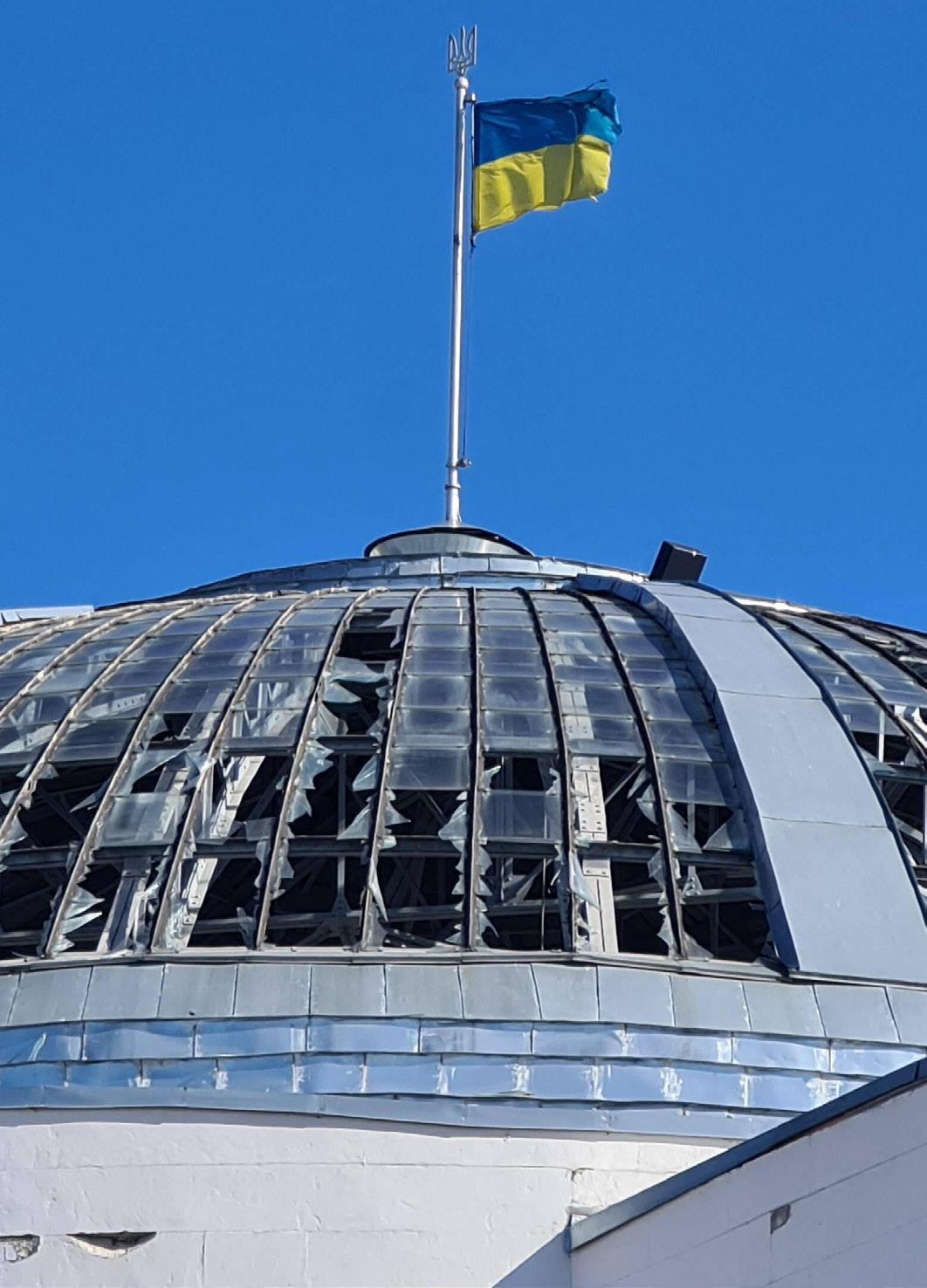

Table of contents
AND SOCIETY War in Ukraine: A Test for the Free World
ECONOMY
Economic Freedom Above All 10-13
REAL ESTATE
Polish Office Market Q2 2022 14-15
Investors Feel Safe Again in Poland 16-17
BUTIK | 18
THE BUZZ | 19-24
Nordic Painting on Show Fascinating glimpses of Warsaw in the 1990s
Five Flavors of Asian Film
The best of Ukrainian cinema brought to Polish audience Olympus at Collegium Nobilium Theater
Artistic commentary on Polish post-transformation landscape Exhibition Pays Tribute to 1944 Wola Massacre Victims
Matilda the Musical hits Warsaw Rodin - Father of Modern Sculpture at Łazienki
CEO
Juliusz Kłosowski, tel. (+48) 22 299-55-60
Accounting
Published by WV Marketing Sp. z o.o.
Editor-in-Chief
Andrzej Jonas, tel. (+48) 22 299-55-60
Managing & Online Services Editor
Witold Żygulski, tel. (+48) 22 299-55-60
Moto Section Coordinator
Bartosz Grzybiński, tel. (+48) 22 299-55-60
The Wrocław Voice
Barbara Deręgowska, tel./fax. (+48) 71 783-61-29, mobile: 501 154 416
To
BUTIK | 25 MOTO
Porsche Panamera 26-30
IN BRIEF | 31-33
Renault Strengthens Its Position as The Leader in Van Sales in Poland What’s Next for Internet Prices? Volkswagen’s „Way to Zero” Change of Company Name New Prologis Facility
SCIENCE
Space Decade for Poland 34-35
GREAT GEAR | 36
Garfish - a dive watch by Polish brand Xicorr Mio MiVue C580 - safety in all conditions Garett Elegance RT
Beata Robak, tel. (+48) 22 299-55-60
Magazine Layout
Michał Lis
Office Manager
Anna Krawczyk, tel. (+48) 22 299-55-60
Address:
29 Jana Olbrachta St. Apt. 22, 01-102 Warsaw
Internet site http://www.warsawvoice.pl e-mail: voice@warsawvoice.pl
Advertising Department e-mail: advertising@warsawvoice.pl
Distribution & Subscription
Anna Krawczyk, tel. (+48) 22 299-55-60 e-mail: distribution@warsawvoice.pl
Address
29 Jana Olbrachta St. Apt. 22, 01-102 Warsaw, tel. (+48) 22 299-55-60
Cover photo: PAP/ITAR-TASS
by e-mail, use the following format: firstname.surname@warsawvoice.pl
WAR IN UKRAINE: A TEST FOR THE FREE WORLD
The eighth month of the war unleashed by Russia in Ukraine has passed; what are your thoughts on the course of hostilities so far?
Let’s recall what was happening before Feb. 24, the day the Russian invasion began. Putin talked about the denazification and demilitarization of Ukraine, thus jus tifying the start of his aggression. Everyone wondered what he meant. Today we can all see that his original strategic plan was to seize all of Ukraine, establish a Moscow-depen dent government there and appoint his governor. Initially, it seemed that Putin only wanted to seize the separatist Do netsk and Luhansk regions as well as the southern corridor connecting Crimea to the Kherson and Zaporizhia regions. He intended to rule the rest of the country with the help of his puppet team installed in Kiev. Former President Viktor Yanukovych or billionaire Viktor Medvedchuk, recently ex changed for Ukrainian prisoners of war, including defenders of the Azovstal fortress, were mentioned as its leaders. And then suddenly it turned out that the incompetent army of the Russian Federation attacked Ukraine from six operational directions, contradicting all the principles of operational art (the ratio of attacking to defending forces, no main direction of attack, the system of reconnaissance, command, logistics, a lack of cooperation, communications, poor training, fail ure to overpower Ukraine’s air defense system, low morale – one could go on for ever). And another important factor working in favor of Ukraine: pervasive corruption in the Russian Federation and its armed forces.
The result was failure: The Russian army suffered a se vere defeat near Kiev, the most painful proof for Moscow be
ing the loss of hundreds of tanks, transporters, artillery systems, communi cations and command equip ment, helicopters and other aircraft, and the defeat of an elite unit of landing and assault troops, who were supposed to take control of the Hostomel airport in the first hours of the invasion. Had this attack been suc cessful, it would undoubtedly have been a game changer: The Russian-controlled airfield would have been able to land transport aircraft like the Il-76, which are capable of carrying heavy equipment such as tanks. An effective attack on the Ukrainian capital would then have been possible.

AFTER THE DEFEAT AT KIEV, PUTIN PROCEEDED WITH PLAN B, WHICH INVOLVED STRIKING FROM THE EAST AND NORTHEAST IN ORDER TO CUT UKRAINE ALONG THE DNIEPER RIVER LINE
After the defeat at Kiev, Putin proceeded with Plan B, which involved striking from the east and northeast in order to cut Ukraine along the Dnieper River line. This, too, failed, although the Russian army managed to take some Ukrainian territory, after heavy fighting. Putin then focused on seizing as much of the two separatist republics as possible, throwing nearly 85 battle groups into battle there, backed by heavy artillery and air forces that bombed civilian targets that had nothing to do with the military operation. The primary goal was to expand the territory of the Donetsk and Luhansk regions as much as possible, seizing Mariupol and the entire coast of the Sea of Azov, at the same time attacking the territory of Ukraine with a huge number of precision and non-precision missiles, which, falling on civilian targets, inflicted damage on ci vilians and destroyed infrastructure. Unfortunately, the Russians succeeded in this, though at the cost of heavy losses. At this point I must highlight the intrepid, almost heroic defense of the port city of Mariupol, where the de fenders of this city defending themselves in the Azovstal complex tied up significant Russian forces for almost three months, inflicting heavy losses on them. The Russians also succeeded in seizing Kherson and declaring another “peo ple’s republic” there.
Nor can we fail to mention the heroism of the defenders of Snake Island and the subsequent sinking of the Russian Black Sea Fleet’s flagship, the cruiser Moskva, by the Ukrai nians. This was not only a military blow to Russia, but also an image and propaganda blow.
Soon, however, the situation got out of hand for the Rus sians; heavy fighting continued in the Donbass, an attempt to cross the Donets River ended in another defeat for the Russian troops, who lost almost their entire battle group along with their equipment. Other heavy battles were fought in Severodonetsk, where the Ukrainian army put up seri ous resistance, inflicting very heavy losses on the Russians, themselves suffering losses as well. But in this way Ukraine gained some time, during which it received successive new armaments and ammunition from the West as well as mo bilizing and training new forces. The front came to a halt. The Russians proceeded to defend the occupied area. Since March, Ukraine has managed to mobilize and train 700,000 troops; additional brigades were created and successively trained and equipped. Ukraine then received a large amount of modern military equipment from the West, including HI MARS artillery rocket batteries with large numbers of rock ets fired accurately to a distance of up to 70 kilometers. Sol diers very quickly learned how to operate them. In addition, a lot of older armaments were acquired from the Russians.
A few weeks ago, the Ukrainian army launched a coun teroffensive that ended in tremendous success. Russian troops were pushed back near Kharkov, suffering huge losses in the process. An effective strike was carried out at one of the most vulnerable points, between two regiments formed from conscripts of the separatist republics on the border of the Donetsk and Luhansk regions, with Ukrainian forces attacking the poorly trained and demoralized Rus sians. Taking advantage of this success, the Ukrainians in tensified their attack, regaining nearly 40 percent of the ter ritory lost in that direction, while capturing a huge amount of abandoned equipment, ammunition and fuel depots. At the same time, in the southern direction, near Kherson, using HIMARS launchers and air forces in the attack, the Ukrainians hit not only the invading army’s groupings, but also command posts, artillery batteries, weaponry depots and logistics centers, isolating the battlefield and cutting off


VLADIMIR PUTIN’S DECISION ON A “PARTIAL MOBILIZATION” IS NOTHING MORE THAN A DESPERATE ATTEMPT TO FILL THE ARMY’S MANPOWER SHORTAGE RESULTING FROM THE COLOSSAL LOSSES I MENTIONED EARLIER
the Russian troops in Kherson from sources of supply.
A little earlier, the Ukrainians managed to hit the Rus sians painfully in the Crimean Peninsula: More than a doz en SU-24 and SU-25 planes as well as helicopters were destroyed in an attack on the Russian airfield in Novofe dorovka. The attack had a tactical dimension, practically depriving the Black Sea Fleet of air support capabilities, but also a psychological and image-related aspect: Russians no longer felt safe even in the territory of Crimea that they had annexed illegally in 2014. We later saw a panicked flight of Russian tourists and departing residents of the penin sula, terrified by the possibility of hostilities around their places of residence. Despite the ubiquitous state propagan da about a “special operation,” it slowly began to dawn on ordinary Russians that this was simply a war in which the “invincible” Russian army was suffering heavy defeats along particular sections of the front. Shipments of “Cargo 200” (Gruz 200), i.e., coffins with killed soldiers, have be gun arriving in Russia. The Russians have so far probably lost about 40,000 dead plus 60,000-100,000 wounded and missing in action. This means that of the army of 180,000 that moved into battle on Feb. 24, almost two-thirds have been excluded from combat.
In addition to its tremendous brutalization, non-compli ance with any conventions, expressed in the murder of civil ians, rape, torture, demolition of cities and infrastructure and looting of property, in this war we are also seeing such elements as destruction and theft of grain, and its export from Odessa being blocked. There are also the attacks on the Zaporizhia nuclear power plant, which could end in a tragedy similar to that of Chernobyl in 1986. But on the other hand, we also see the heroism and high morale of the Ukrainian people, soldiers, and the steadfast leadership of President Volodymyr Zelensky, his entourage as well as the excellent work of the Ukrainian General Staff and the vari ous commands down to the lowest level. All this is happen ing with continued support from the West.
What do you think of the “partial mobilization” now un derway in Russia, which is expected to involve 300,000 people? On the Komsomolskaya Pravda daily’s website, I recently read an interview with former Deputy Prime Minister and Interior Minister Anatoly Kulikov, who said that “the future of Russia today depends on these people.”
Vladimir Putin’s decision on a “partial mobilization” is nothing more than a desperate attempt to fill the army’s manpower shortage resulting from the colossal losses I men tioned earlier. We have already seen such attempts. After the first losses on the front line, they sent in Putin’s “private army,” the so-called Wagner Group, and the combat units of the Russian president’s Chechen vassal Ramzan Kadyrov, as well as mobilizing local forces in the Donetsk and Luhansk regions (two regiments were created there, with no practical combat value), conscripting prisoners, who were guaran teed amnesty in exchange for participation in combat, and even pulling contingents of Russian troops from Syria and Abkhazia to replenish losses.
The same mess that we see every day during the war can also be seen in the process of this strange mobilization (there is no such thing as a “partial mobilization” in Russian legislation). A country that has enormous mobilization capa

bilities today has problems with calling just 300,000 people to arms. All over the world, trained reserves are called up in such cases, but in Russia today, they are conscripting anyone they can catch; candidates for soldiers are fleeing abroad in droves or hiding wherever they can, there are shootings at conscription points and so on.
Of course, the number of 300,000 new soldiers is very serious, but transforming quantity into quality is another matter. According to the rules of the art of war, which, by the way, have probably all been violated in Russia, people who are to be mobilized are notified first, then they are mo bilized and sent to training centers, where they are equipped and trained, then the units they are to go to are identified or new units are formed, and these undergo further stages of training. In basic terms, this takes two to four months. In Russia today, it looks like people who have ever under gone any military training at all will be sent to the front after a week or two to replenish units whose losses sometimes reach 30-40 percent of their personnel. The combat efficien cy of such a recruit will be close to zero.
Another issue is equipping the new troops. To do this, it is necessary to take equipment out of storage, remove any protection, refurbish the equipment, bring it into working order. There is a shortage of communications systems, op toelectronics, targeting systems, systems necessary on the battlefield. Of course, the way things are in Russia, half the equipment has been stolen and half exchanged for liquor.
New equipment cannot be manufactured quickly because Russia already has a shortage (caused by international sanc tions) of components such as microprocessors, semiconduc tors, and optoelectronics. Without them, any tank, plane, or missile is a pile of scrap metal.
Of course, the mobilization of 300,000 recruits should not be downplayed. Even in the role of untrained recruits, representing zero combat value, combined with what is al ready operating on the front lines, this number poses a threat.
But Ukraine has the capacity to respond. No time has been wasted; the Ukrainians have not only fought the invad ers, but also pursued a parallel process of mobilization and training, equipping units with modern weapons. Human re sources are also not insignificant in Ukraine, the morale of the army stands very high, Ukrainian troops are gradually moving from defensive positions to attack, in a drive to re gain the territories lost after Feb. 24.

How do you think the Russian government intends to act in the coming months?
Putin’s political intention is to absorb the territories of the Do netsk, Luhansk, Zaporizhia and Kherson regions, i.e., all the regions of Ukraine where Russian troops are stationed today, into the Russian Federation, through referendums that are il legal under international law and obviously rigged. Then, ac cording to Moscow’s plan, these territories would become an integral part of the Russian state, just like the equally illegally occupied Crimea. According to Russian doctrine, it will there fore become permissible to use all possible military means to defend them, which will become another “Patriotic War.”
This is what happened when Putin announced the annex ation of these regions by the Russian Federation on Sept. 30. This is territorial rape on an unprecedented scale in the history of the 21st century. With this act, he also justifies the already widespread mobilization to his own people. This brings us to another point, which was recently raised by Russian Foreign Minister Sergei Lavrov in his typically brazen speech in the UN. He said in New York that if any one attacks the lands of the Russian Federation, all possible means will be used, including weapons of mass destruction. The question is: where, against whom and what for? It is primarily meant to intimidate the Ukrainian and Western societies. The charm of nuclear weapons lies in deterrence and intimidation by threatening to use them.
Of course, the support of the West is extremely import ant. Without it, Ukraine would have very little chance of defending itself against the Russian onslaught. The determi nation of the free world is great; its leaders, headed by the American president, express it time and again in speeches at international forums. It was also confirmed at the recent ses sion of the United Nations General Assembly in New York. Moscow’s threats, repeated daily, are of no use.
Should the possibility of Russian nuclear strikes be taken seriously today?
I believe that the probability of such an escalation of the war exists but is very small. This is evidenced, for example, by the attitude of China, which made it clear at the recent summit in Samarkand that Moscow cannot go as far as such measures. The international community will never accept
FROM A PURELY MILITARY POINT OF VIEW, THE USE OF NUCLEAR WEAPONS IN THE CURRENT CONFLICT IS ABSURD
it. I also believe that there are still people in Putin’s entou rage who have common sense and know that the use of such weapons will cause a global cataclysm. In response, NATO could, for example, launch a massive conventional strike against, say, the Black Sea Fleet, sinking it completely, in cluding its submarines, or any other sensitive object valuable from Russia’s point of view. Moscow is well aware that the Americans have such capabilities.
Admittedly, the Russian president is enormously deter mined, emotionally unstable and finds it difficult to back down, but not only external but also internal pressures are already emerging. Decentralist processes are noticeable in Russia, especially in the regions where most of the soldiers currently fighting in Ukraine come from: Ingushetia, Dages tan, Buryatia or even Chechnya, ruled by Kadyrov with an iron fist.

From a purely military point of view, the use of nuclear weapons in the current conflict is absurd. Where would such charges, even small tactical ones, be fired? Over Kharkov, Kherson, Zaporizhia? Over a cluster of fighting troops? The fact is the directions of winds in this part of the world (they blow from the south to the northeast) will send the radioac tive air over Russian territory. Moreover, the United States and NATO have put all possible monitoring measures in place: space, cyber and personnel, that can detect any signs of intent to use such weapons, with a view to preventing this.
However, we must remember that Putin’s war, in addi tion to many other horrific and tragic consequences, has also provoked a food crisis in African countries due to the partial blockade of grain exports from Ukraine, an energy crisis, and now, with this latest nuclear scare, has caused fear and terror in Ukraine and Western societies.
So, what further course of the war do you foresee? The Ukrainian army has just liberated Kupiansk and Lyman. It is conducting harassment operations in the southern direc tion, and is slowly bringing air power into action, reducing the slight advantage the Russians had for several months in this aspect of the war effort. At the same time, Zelensky is soliciting political and military support, and receiving more supplies of anti-aircraft and missile weapons.
Putin’s criminal decision to plunder the lands of the aforementioned regions has complicated the situation for the Ukrainian leadership, as Putin is well aware. That is why President Zelensky has asked for an accelerated proce dure for Ukraine’s admission to NATO. This is very difficult at the moment, as it requires the consent of all the NATO countries, and Ukraine is in a defensive war with Russia. Its possible inclusion in NATO structures would now auto matically bring the Alliance into the war against the Russian Federation, which would then automatically escalate into a global conflict.
Time, forces, and geography are working in Ukraine’s favor. Of course, winter will be difficult for the Ukrainians, but not as difficult as it will be for the Russians. Russian units are severely cut off from sources of supply, so far away from home bases that it becomes impossible to maintain the supply chain. They are stationed in ruined areas that they themselves have ruined, with no repair facilities for equip ment, let alone medical facilities for the wounded.
It is expected that the war could continue for quite some time yet.
But seeing the perversity and insolence of the authorities in Moscow, it cannot be ruled out that Putin will put for ward proposals for a peace treaty in which the lands he has
illegally occupied must be recognized as Russian territory. The Ukrainian authorities will certainly not agree to such a proposal.

For many decades, the world believed in the power of the Russian army, treating it as one of the undisputed world powers; has the war in Ukraine changed this opinion? We were all victims of Russian propaganda, which is still repeated today, except that it is probably only for internal use; for the rest of the world, the picture drawn by the war is rather clear. We watched films of Russian maneuvers, we watched military parades on Red Square (although even there, a state-of-the-art Armata tank suddenly broke down during a parade a few years ago). Only now do we know that truly homeopathic amounts of new equipment were put on display, and that Russian generals habitually lied to Pu tin, informing him of the flourishing state of the army, of the constant modernization of the armed forces. Of course, Russia’s army was being transformed into a modern one, in a process that accelerated especially after the campaign in Georgia, but it was all largely false. Apart from the special
airborne units (which, however, failed to break the resis tance of the Ukrainians at the Hostomel airfield) and a few elite units such as the Taman and Kantemirov tank divisions, everything was poorly organized and equipped, as well as poorly commanded. The whole concept of massed strikes by tank troops, dating back to World War II, was largely anachronistic. There was a lack of communication systems, long-range target detection and indication, interoperability, logistics, training and, above all, morale. The air force is a case in point: In the first phase of the war in Ukraine, it was successful; Russian propaganda cried out in delight at the supposed complete control of the Ukrainian airspace, but it soon turned out that the underestimated Ukrainian anti-aircraft defense was able to down dozens of Russian planes and helicopters with its own BUK-21 systems. The Russians also failed to overpower the Ukrainian radar or command systems.
The Russian army also lacks the ability to use precision munitions effectively at long ranges. A large number of “pre cision” missiles are landing in Ukraine in the middle of no where.
To sum up, apart from nuclear missile strategic forces and submarines armed with ballistic missiles, the Russian land forces do not present much danger, and are largely overrated. Another thing is that we also don’t know what state Russia’s nuclear arsenal is in; it is not at all out of the question that a sizable portion of it may not be com bat-ready, and the procedures for its use are imperfect and unreliable, although they have reportedly been improved during military exercises.
When the world’s second army cannot cope with the world’s twenty-second, the picture is rather clear. No won der, then, that Putin keeps repeating that he is not fighting with the Ukrainian army at all, but with the entire West or the whole of NATO.
The current war has changed the picture of the European and global security system; what will it be like now and what role should Poland play in it?
We had the first signs that the world was changing, for the worse, back in 2014 after the seizure of Crimea. Back then, however, the West, especially European countries, was still convinced that things would end there. But it was easy to conclude from Putin’s and Lavrov’s words that Russia want

ed to change the global security architecture, push NATO away from its borders, demilitarize the countries that joined the Alliance after 1999, and force the withdrawal of NATO military units and installations from their territories. We can imagine how that would have ended. Today, the Kremlin has achieved the opposite; two countries traditionally shying away from military alliances – Sweden and Finland – are joining the Alliance. The security architecture is changing in favor of NATO countries, in favor of the free world.
The Russian aggression has also made many other coun tries realize that they must be prepared to defend them selves effectively against an invader before any help arrives. Taiwan, for example, is a case in point. China, a major world player, has led to Russia slowly becoming its vassalized cli ent rather than an equal partner. However, Beijing has also noticed that Europe has united in the face of the Russian invasion, and the role of the United States has increased, including in the Far East. Countries such as Japan, Australia, South Korea, Malaysia, New Zealand, and Singapore see the need to strengthen security in the face of the neighbor ing presence of China, which, while not planning a military attack, has an active policy of strengthening its army, navy and air force.
As an active and loyal NATO member, Poland is consis tently strengthening its defense potential. Every member state of the Alliance, in accordance with Article 3 of the NATO Treaty, is obliged to continuously strengthen its armed forces at a level that ensures the reliability of the de fense system. As part of this obligation, Poland is increasing its military potential and defense budget. The lessons that emerge from the conflict in Ukraine are absolutely clear. We must be prepared to hold our own territory in the event of a possible attack until the arrival of NATO forces, to cooper ate with them and, perhaps most importantly, to be perma nently present in the common defense system.
The recently adopted Homeland Defense Act envisions the size of the Polish armed forces at 300,000 soldiers. However, this process must take time. In parallel, we need to saturate our army with state-of-the-art means of combat, including air defense, target identification, the ability to strike targets, network-centricity, communications, mobile logistics, improvement of the command system, resistance to cyber and radio-electronic strikes, maneuver capabilities, operational preparation of the terrain on which we are like
ly to conduct operations, continuous learning and training, preparation of personnel reserves, etc. We must also be able to interact with other NATO armies, updating and exercis ing elements of contingency plans within the framework of the NATO defense strategy. It is also necessary to improve and develop the Territorial Defense Forces by including them in the plan of use together with operational troops and civil defense. In other words, we have to improve our entire defense system. So, we can see that this is a continuous and complicated process requiring the alignment of many factors and related issues.
We don’t want to attack anyone, but we must be prepared to attack an attacker heading toward our borders while they are still on their territory, so as not to allow situations like we see today in Bucha, Izium and many other Ukrainian cities where civilians are murdered and infrastructure de stroyed, or situations in which we would give up some parts of our own territory to take them back laboriously later. It is necessary to defend ourselves in such a way as to prevent the loss of any piece of Polish territory.
Analyzing the course of the Russian-Ukrainian war, one can also conclude that as a result of the hostilities in Ukraine so far and the losses suffered there, as well as the sanctions imposed on the Russian Federation, the Russian armed forc es, and especially ground troops, will need about 15 years to rebuild potential capable of carrying out effective offensive operations. But at the present stage, especially after the imple mentation of the mobilization system and the replenishment of frontline units, they still present a huge threat to Ukraine.
General Mieczysław Bieniek is a for mer NATO Deputy Strategic Com mander for Transformation. He was the first Polish officer to assume such a high command position in NATO.
Bieniek commanded elite units of the Polish Army - the 6th Airborne Bri gade and the 25th Air Cavalry Division.
He was commander of the Pol ish UN Military Contingent in Syr ia in 1989-90. He was also head of observers in the UN Peace Mission in Western Sahara. From July 1998 to January 1999, he commanded
the Nordic-Polish SFOR Brigade in Bosnia and Herzegovina, as the first Polish general to undertake NATO service. In the fall of 1999, he was appointed head of the Training and Exercise Division of the NATO Al lied Forces in Europe (SHAPE) Headquarters in Mons, Belgium. He was also in charge of NATO Rapid Reaction Force exercises of forma tions such as ARRC (Allied Rapid Reaction Corps) and AMF(L) - Al lied Mobile Forces (Land).
In 2002, he took on another inter
national challenge by assuming the position of first deputy commander of the 3rd NATO International Rap id Reaction Force Corps with a com mand in Turkey - Istanbul.
From January to July 2004, he commanded the Multinational Stabi lization Force Division in Iraq.
In 2010, he becomes the only Pole to date in NATO’s military structures (a four-star general) and takes up the position of NATO Dep uty Commander for Transformation, which he held until September 2013.
THE RECENTLY ADOPTED HOMELAND DEFENSE ACT ENVISIONS THE SIZE OF THE POLISH ARMED FORCES AT 300,000 SOLDIERS. HOWEVER, THIS PROCESS MUST TAKE TIME
ECONOMIC FREEDOM ABOVE ALL
Economists predict that Poland is facing its big gest economic crisis in more than 30 years, comparable - although this is hard to believeto the one from the time of the systemic breakthrough; do you agree with such a forecast, and if so, what are the reasons for this state of affairs?
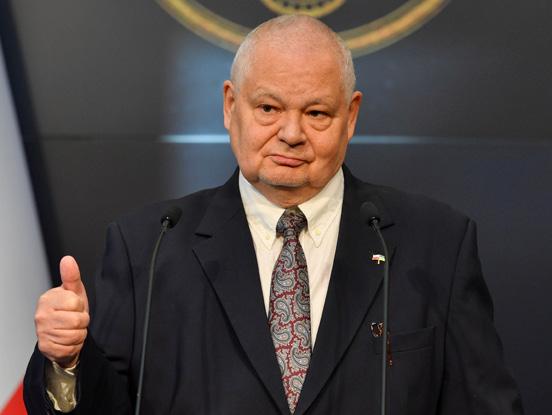
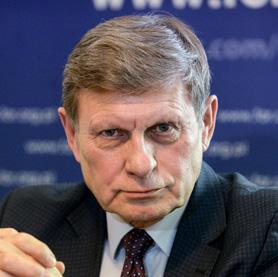
Reservations about the consequences of the ruling Law and Justice (PiS) party’s policies in the economy and also the violation and the destruction of the rule of law, were raised almost immediately after the party won the parliamentary elections in 2015. It was apparent what this could, in all likelihood, lead to. The policy of increasing the politiciza tion of the economy from month to month, of increasing the role of the state within it, which is always a political role, could only result in one thing. It was therefore not difficult to predict that a serious crisis was coming. Negative effects, as always, arrive late. There is always a lag time between a bad thing and its effects on the economy. For the first two to three years of the United Right’s rule, we had a period of prosperity in the global economy. Now, the fatal errors in domestic policy are being compounded by the recession that has occurred in almost all countries that count in the global economic system.
Therefore, we can be certain that we will find ourselves in a state of stagflation in the coming years, meaning zero or minimal economic growth combined with ever-present high inflation and compounding budget problems. These problems will accrue dramatically, such is the delayed effect of the government’s misguided economic policies. The causes have already occurred, so no matter who gov erns Poland after next year’s parliamentary elections, the
effects will manifest themselves. This does not mean, of course, adopting a stance of not caring who comes into power, because we are interested in the future. The cur rent ruling team has done a lot of wrong, which is be coming acute not only because of the external crisis but because of the deformations of the state system that have occurred and are still occurring. There will be a huge bur den of responsibility on those who will, hopefully, replace the PiS government.
There is not the slightest doubt about what needs to be done to restore the rule of law in Poland, meaning
an authentic tripartite division of power. What needs to change in particular is the situation in which the courts and the prosecutor’s office have turned into a tool for persecuting the opposition, political opponents of PiS, acting in an absolutely ruthless manner, violating all rules of decency. In addition to the activities of the judi ciary, the work of the police and special services, also all too often treated as a tool in the political struggle, will also have to be looked at closely. I see no solution here other than firm and swift action immediately after the new team comes into power. Fortunately, it seems that the current opposition, regardless of which grouping is involved, is fully aware of this.
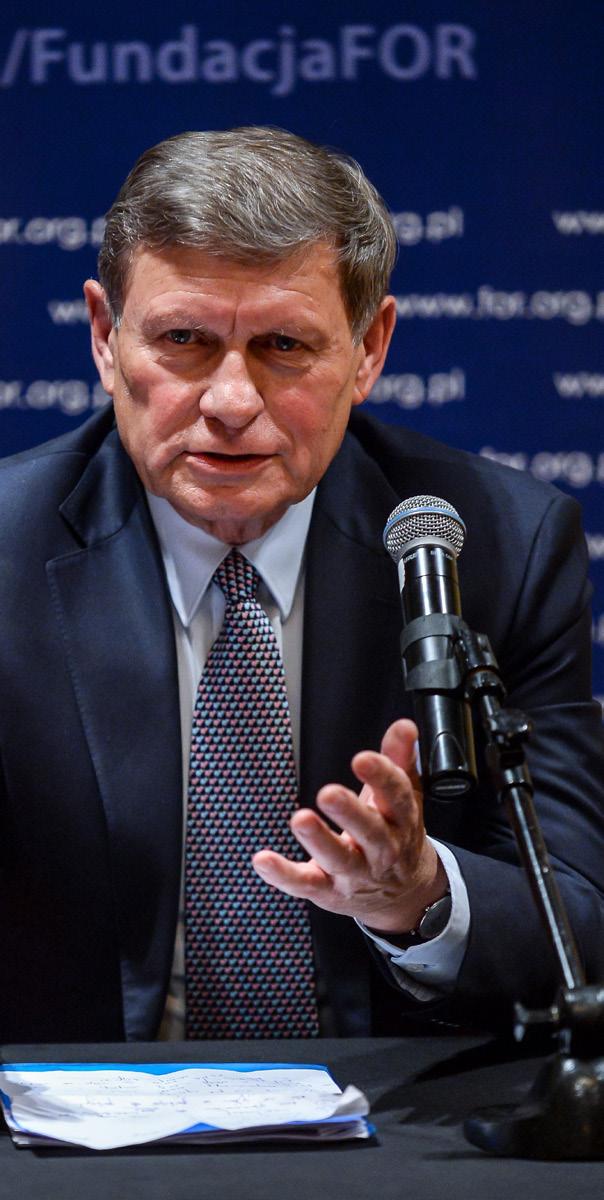
Of course, we might have to reckon with an obstacle to the introduction of new regulations aimed at restoring the rule of law in Poland, namely the attitude of President An drzej Duda, a politician with roots in PiS. But if the opposi tion gains a sufficient majority in the parliament, this is not an insurmountable obstacle.
lem today, in my opinion, is the alarmingly low level of investment. It currently stands at less than 20 percent, lower than in most Western countries (not counting Greece). This raises serious concerns about the future. An extremely important test for the future government will therefore be to change this situation, to rebuild the investment climate, to rapidly increase the investment rate.
Economic recovery is much more questionable. For some hard-to-understand reason, the opposition parties, including the largest of them, the Civic Platform (PO), are not revealing what they intend to do to restore sta bility to the economy, to get Poland back on the path of economic growth, to start developing again. To make matters worse, there is no shortage of examples of par liamentary support for PiS’s destructive budget policies, including and mainly handouts, i.e. offering more and more money to different groups without looking at the consequences, including long-term ones. It is said that elections are not won without populism, but the propo nents of this idea confuse populism with popularity. The two are not synonymous, even though both words begin with the letter “P.” The assumption that public opinion will favor the group that outbids the others with its pop ulism leads to the systematic destruction of the founda tions of a healthy economy. Populism excludes respon sibility, the rationality of decisions both for the moment and those with far-reaching, systemic consequences. It is fraudulent politics.
One argument being raised in the political discussion in Poland is that, despite its increasingly criticized policies, PiS is still supported by about 30 percent of citizens. But this is not a majority.
Returning to strictly economic issues: The basic prob
THE NBP, UNDOUBTEDLY AT THE BEHEST OF THE GOVERNMENT, CONTINUES TO PRINT MONEY WITHOUT COVER, WHICH CONTINUES TO FUEL INFLATIONARY PROCESSES
How can this be accomplished?
Part of the responsibility for the current situation lies with the populist PiS government, but even before, things were not as they should have been. Investors are guided by cal culated profit, so first of all, it is necessary to make a reli able analysis of what part of investment in Poland in recent years has fallen to state, government projects, and what part to private investment, including foreign direct investment (FDI). The government boasts today that investor confi dence in Poland is not waning, and is even growing, and gives some examples of projects, but experience teaches us to treat such declarations with caution. I can only add that I personally feel especially great skepticism about statements on this issue – and by no means only on this one – made by Prime Minister Mateusz Morawiecki.
From 2001 to 2007 you were the governor of the National Bank of Poland (NBP); inflation in Poland has been hitting new record highs, recently exceeding 17 percent. What is causing this?
Inflation is divided into two parts. The so-called core infla tion is due to the domestic demand factor, the other part is related to price shocks that come from outside. From the analyses that I am aware of, including those prepared at the Civic Development Forum [an economic think-tank found ed and headed by Prof. Balcerowicz in 2007], it appears that most of the inflation in Poland is attributable to core inflation. Therefore, the argument that this is, as the prime minister calls it, “Putinflation,” i.e., that the crisis unleashed by the Russian president after the armed aggression against Ukraine is to blame, does not withstand criticism. Domestic factors are decisive. The primary one is the central bank’s far-too-late response in the form of interest rate hikes. It was
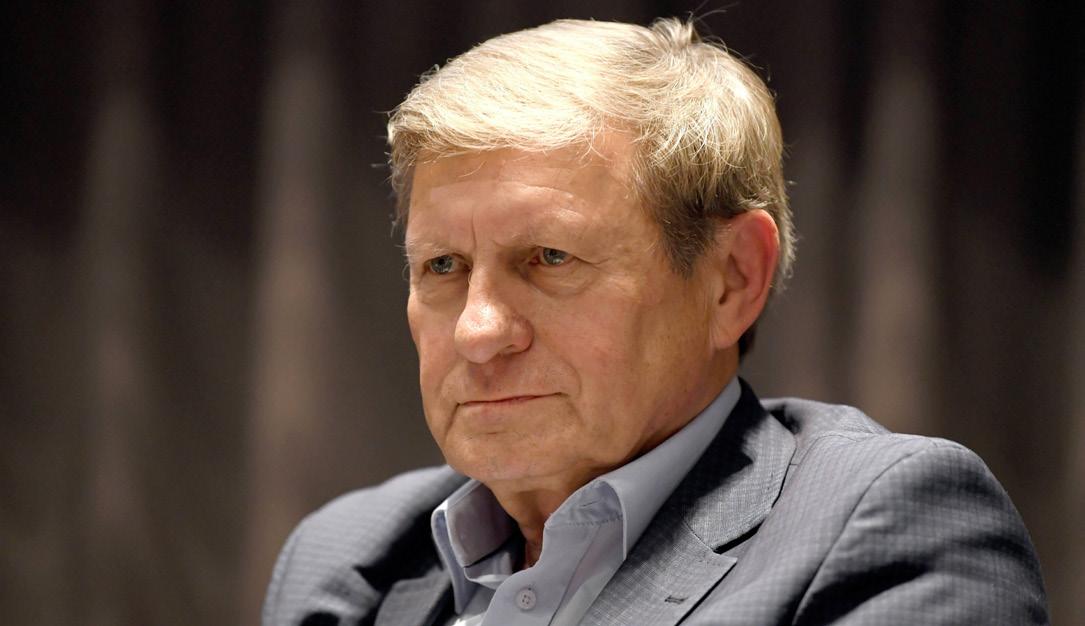
the right move, of course, but very belated, on top of which the public had been told for years, even as late as the end of last year, that there would be no rate hikes. Meanwhile, the Monetary Policy Council (RPP) has already raised the rates 11 times since then. The NBP’s reference rate has risen to 6.75 percent from a near-zero level of 0.10 percent. Now the central bank is considering whether the level is already sufficient or should be raised further; some economists au gur a bleak scenario of the reference rate even reaching 9-10 percent. This is because the rate of state spending continues to rise, and with it the rate of the budget deficit. Experts con sider next year’s draft state budget presented by the govern ment to be completely unrealistic. The NBP, undoubtedly at the behest of the government, continues to print money without cover, which continues to fuel inflationary process es. One can say jokingly – though unfortunately, state finan cial policy is no laughing matter – that the team of Mateusz Morawiecki and [NBP Governor] Adam Glapiński is respon sible for inflation.
Stabilizing monetary and fiscal policy is absolutely fun damental in Poland today if we want to avoid a crisis of enormous proportions, a long-term one at that. The state of stagflation that awaits us will have a negative impact on both income and expenditure. The gap between state rev enue and spending is growing dramatically; FOR analyses show that it will be incomparably worse than the govern ment predicts in its forecasts and budget plans. All this will happen, it needs underlining, under conditions of a global economic crisis.
Of course, a sizable part of the troubles associated with global price increases, primarily of energy raw materials, is due to the crisis caused by the war in Ukraine. If, which is what we all wish for, this factor disappeared and there was
some stabilization, the fight against inflation would certainly be easier. But this, as we know, is a long way off. In addi tion, domestic pro-inflationary factors will remain, and they should now be the main focus.
You talk about a rational state financial policy, but next year is a parliamentary election year, and we know that those in power will mainly want to win over the electorate by continuing to inject money into already over-the-top social pro grams such as the 13th, 14th and perhaps 15th pensions, family allowances, further wage increases for protesting pro fessional groups, and so on....
The law of the political jungle can be no excuse. Harm to the economy cannot be tolerated. It must be made clear that a budget disaster is looming. We already have a seri ous drop in economic growth, and analysts are predicting it will stop altogether. Without a radical change in economic policy, especially fiscal policy, the situation will not change. This change must be accompanied by the liberalization of the economy; without this, GDP growth will not take off. If the current ruling team does not decide to quickly reform economic policy, they should be held firmly accountable for this; it is simply acting to the detriment of the state.
What do you think of the idea, presented recently by Deputy Prime Minister and Minister of State Assets Jacek Sasin, of a tax on excess profits? All companies – state-owned and private – that achieved a profit increase of more than 20 percent year-on-year would pay a 50-percent tax that, among other things, would be used to finance additional expenses of local governments and public institutions resulting from the increase in energy prices?
One columnist described this idea as a “Bolshevik surtax” and I fully agree with this term. If excessive profits are made by state-controlled enterprises, no special tax law is needed to investigate this. Extending such a tax obligation to private entities is nothing more than resorting to methods known from the period of the People’s Republic of Poland, when tax offices-imposed duties, at their whim, on the few private entrepreneurs of the time, who, by the way, contributed sig nificantly to increasing economic growth and improving the dire market situation. This is a desperate attempt to get ad ditional money into the empty state coffers, a cure far worse than the disease. The authors of this idea don’t know where the problem lies – are taxes too low or is there too much spending?
In your opinion, does the current opposition have any pre cise plan for economic reforms?
This is a difficult question. Today’s opposition groups differ greatly among themselves, and sometimes not very rational views on economic issues clash. This also applies to the largest opposition party, the PO, within which people also do not agree completely on the fundamental directions of future necessary reforms and how to implement them. Most of the opposition today is focused on criticizing the govern ment’s policies, paradoxically also those of its populist ele ments that, as I said earlier, it supports during parliamentary votes. I am also a bit concerned that I often hear more sen sible statements about economics from Szymon Hołownia, the leader of political newcomer Polska 2050, than from experienced PO politicians.
If you were now to create a second “Balcerowicz Plan” [the original plan was a package of systemic reforms introduced by Poland’s first non-communist government in the fall of 1989, when the country was transitioning from a centrally controlled economy to a market economy], what would be its main pillars?
They are obvious. First, combating inflation, which is an evil, though fortunately an evil felt by the people, so it will be easier to win them over to necessary changes. Second ly, firmly restoring the rule of law, which will of course en able the restoration of normal relations with the European Union, which will be followed by the unblocking of EU funds due to Poland from the National Recovery Plan (KPO). The country needs them to finance numerous investment proj ects, especially in the pending transition period until the European and global economies achieve a balance that was first disturbed by the COVID-19 pandemic [to combat the economic consequences of which the Recovery Fund was es tablished], then by the war unleashed by Russia in Ukraine.
The theory promoted by the government in recent months, that Poland will be able to cope perfectly well without the near PLN 160 billion from the European Commission, that economic plans can be carried out at our own ex pense, and that Poland can withdraw completely from co operation within the framework of the EU Recovery Fund package, is completely absurd. Third, removing politics from the economy, shutting down the PiS “manor farm” created over the past seven years [i.e., treating state assets like one’s own property], where every Treasury-owned company is swarming with the “family and friends” of ministers or other government officials, usually completely incompetent and often using their position to pursue busi ness for their own benefit, by means of methods bordering on the illegal or simply illegal. Private companies would never employ such people. In short: deregulation and pri vatization of the economy. A draft privatization plan with the participation of private pension funds has already been prepared.
Do you see any area in the Polish economy that can become a fast-acting lever for accelerating its growth?
As a rule, I shy away from predicting “economic tigers” –this has to be done by the market. Everything, I repeat, ev erything should be based on economic freedom in the broad est sense. Without it, nothing will succeed.
IT MUST BE MADE CLEAR THAT A BUDGET DISASTER IS LOOMING. WE ALREADY HAVE A SERIOUS DROP IN ECONOMIC GROWTH, AND ANALYSTS ARE PREDICTING IT WILL STOP ALTOGETHER
POLISH OFFICE MARKET Q2 2022
The Polish office market has more than 12.6 mil lion sqm of modern space at the end of Q2 2022.

Traditionally, Warsaw remains the leader in to tal stock, with eight major regional markets led by Kraków and Wrocław not slowing down. An example is Tricity, which joined the ranks of office millionaires in the second quarter of this year. Optimism from rising demand is emerging from the market picture.

At the end of June 2022, Poland’s total stock of A-class office space stood at more than 12.6 million sqm. Develop er activity in the second quarter of this year totaled 103,900 sqm, reflected in completing 12 office buildings. Counting projects delivered to the Polish office market from January to June 2022, 34 developments were provided, with a to tal area of 440,800 sqm. Among the most significant of fice buildings completed in the period under review were Forest Tower (51,500 sqm, HB Reavis, Warsaw), KTW II (39,900 sqm, TDJ Estate, Katowice), and Midpoint71 (36,200 sqm, Echo Investment, Wrocław).
In the case of Warsaw, two projects were completed in the second quarter of this year, i.e., SkySAWA (22,800 sqm) and Intraco Prime (12,800 sqm), which increased the total stock of the capital’s office market to nearly 6,270,300 sqm. The completely new supply in the capital in H1 2022 is more than 129,000 sqm. The proper construction site, however, is the regional office markets. Developers deliv ered as many as 26 developments with a total of 311,800 sqm in H1 2022. From April to June this year, another ten projects were completed, among which the largest was Phase I of The Park Kraków project (11,700 sqm, White Star) in Kraków. In terms of new supply in regional cities, the largest number of projects was delivered in Kraków (about 26,300 sqm), Tri-City (18,800 sqm), and Łódź (18,800 sqm). High development activity translated into an increase in total office space stock in the eight major office markets (Kraków, Wrocław, Tricity, Pozna ń, Kato wice, Łódź, Szczecin, and Lublin) to 6,335,700 sqm. The
largest business centers after Warsaw remain in Kraków (1,666.200 sqm), Wrocław (1,284,500 sqm), and Tricity (1,010,900 sqm).
New supply in the office market in the second quarter of 2022 slightly affected vacancy rates. The Polish market has about 1.71 million sqm of space available immediately. In Warsaw, at the end of June 2022, the vacancy rate indi cated 11.9% (747,700 sqm), with a very noticeable shortage of vacant space in central zones. In regional office markets, on the other hand, 961,000 sqm remains available for im mediate lease (15,2%). The highest recorded vacancy rate remains in Łódź (18.6%) and the lowest in Szczecin (4.9%).
After the first half of 2022, the total volume of lease transactions in the Polish office market ended at 829,500 sqm. In the first three months of 2022, tenants signed contracts for a total of 427,700 sqm (WAW 267,200 sqm.; regions 160,500 sqm), with an additional 401,800 sqm leased between April and June this year (WAW 212,200 sqm; regions 189,600 sqm). In Q2 2022, regional cities recorded the highest demand in Kraków (73,900 sqm), Wrocław (25,600 sqm), and the Tri-City (25,100 sqm). In the capital’s take-up structure between April and June this year, occupiers most often opted for renegotiations (48%), which surpassed new contracts (45% including pre-leas es) and expansions (7%). By contrast, in the regional of fice markets during the same period, the highest share of demand went to new contracts (57%, including pre-leases and subsistence contracts), renegotiations (35%), and ex pansions (8%).
“We are seeing high demand in Warsaw, resulting in de clining vacancy rates in central zones. Tenants at this stage are not worried about COVID-19. In the case of the next wave, procedures related to greater sanitary safety, such as the introduction of shift work or home office to a great er extent, will be included again. Another consequence of tenants calming down in the context of the pandemic is fewer decisions regarding space optimization. Among the industries that, from our perspective, are increasing their demand for modern office space are law firms, tax com panies, the IT industry, and operators of serviced offices. The growth of the last group is particularly influenced by the increasing number of companies relocating their op erations from the East, mainly from Ukraine. These ten ants often look for smaller spaces for 4-5 people for about a year. Two factors will influence whether companies from the East will become an influential group of tenants choos ing to lease traditional office space in the coming quarters. The first is the degree and time of adaptation to Poland’s conditions and labor market. In contrast, the second is the further fate of military operations in Ukraine,” says Jakub Potocki, Senior Consultant, Office Agency, AXI IMMO.
Among the largest transactions closed in the War saw office market by the end of June, this year were two pre-leases. In the first, PKO BP leased 34,500 sqm in the SKYSAWA complex, while in the second, a confidential tenant from the banking sector will occupy 30,000 sqm in the Forest Tower building. The podium closes with a Q2 2022 deal in which Samsung Electronic Polska (R&D) re newed its lease of nearly 21,000 sqm in the Warsaw Spire C building. In the regions, on the other hand, the most in teresting transactions took place between April and June 2022. Capgemini signed a 13,800 sqm pre-leasing agree

ment in the Fabryczna Office Park B5 building, while Cisco Systems Poland decided to renegotiate and renew a 12,500 sqm lease in the Enterprise Park C complex. The regional podium for the first six months is completed by a new deal signed in the KTW II building, where PWC will occupy nearly 10,000 sqm.
“The key trends worth pointing out for the next few months are that rising demand and limited supply will un doubtedly be reflected in rising rents. Today, estimating how much property owners will raise starting rents for new tenants is difficult. At this stage, it is also more challenging to negotiate incentives in the form of more extended rent vacations or more significant participation in fit-out costs. Fit-out pricing is slowly stabilizing, influenced by greater normalization of prices and greater availability of materi als. Initial fit-out rates for Shell&Core space in Warsaw’s central zones remain at EUR 900-1000/sqm, with the aver age time to complete a turnkey project from contract sign ing taking about 5 to 6 months,” predicts Bartosz Oleksak, Senior Consultant, Office Agency, AXI IMMO.
“In the context of medium- and long-term trends, rising service charges costs should also be pointed out. We expect that for less energy-efficient office buildings, they may start at PLN 30/sqm at the beginning of 2023,” adds Potocki.
AT THIS STAGE, IT IS ALSO MORE CHALLENGING TO NEGOTIATE INCENTIVES IN THE FORM OF MORE EXTENDED RENT VACATIONS OR MORE SIGNIFICANT PARTICIPATION IN FIT-OUT COSTSJakub Potocki, Senior Negotiator, Office Agency, AXI IMMO
INVESTORS FEEL SAFE AGAIN IN POLAND
AXI IMMO experts analyzed the situation of individual sectors in the investment market in the first half of 2022 in Poland.
The total volume of investment transactions in H1 2022 amounted to almost EUR 2.9 billion, which was more than 40% more than in the same period last year. The high value of invest ments demonstrates investors continued strong interest in Polish investment products in all major categories, despite the new geopolitical situation and the war in Ukraine.
The first six months of this year started very well in Poland’s commercial real estate market. At the end of June 2022, a high volume of transactions was registered in the investment market, resulting from several significant ac quisitions launched in 2021. The result obtained was 40% higher than last year and thus like 2020. By sector, the most invested in offices at 44%, followed by shopping cen ters at 28% and warehouses at 24%.
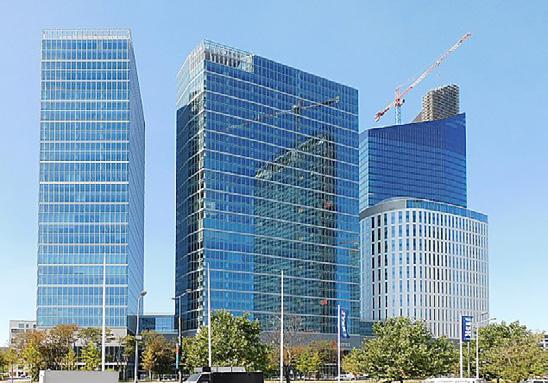
“The biggest unknown in Q2 2022, which influenced the attitude of a large part of investors, was the situation
i n Ukraine. We see that sentiment towards our region is now returning. Still, some investors from Asia and the US are assessing the proximity of the conflict as a greater risk and are adopting a wait-and-see basis for the time be ing. On the other hand, those from Europe and the CEE region are already back in the market,” comments Grze gorz Chmielak, Head of Valuation and Capital Markets, AXI IMMO.
The office sector accounted for 44%, or EUR 1.3 bil lion, of the total transaction volume in the market. Offices
IT IS NOT ONLY WARSAW THAT IS ON THE RADAR OF INVESTORS, BUT REGIONAL CITIES ARE ALSO GAINING IN POPULARITYWarsaw Hub Ghelamco
defended their position during the COVID-19 pandemic. Now employees have returned to offices, demand in the market is returning to normal, which translates into an up ward trend in lease rates and the increased popularity of this asset class among investors. An important signal for the sector was Google’s purchase of buildings B and C of The Warsaw HUB complex from Ghelamco for EUR 583 million. It was a record transaction on the office market. At the same time, it is not only Warsaw that is on the radar of investors, but regional cities are also gaining in popular ity. Quite large transactions took place in Wroclaw, with the largest one in Poznan, where Estnine bought building D in the Nowy Rynek complex from Skanska for about EUR 121 million.
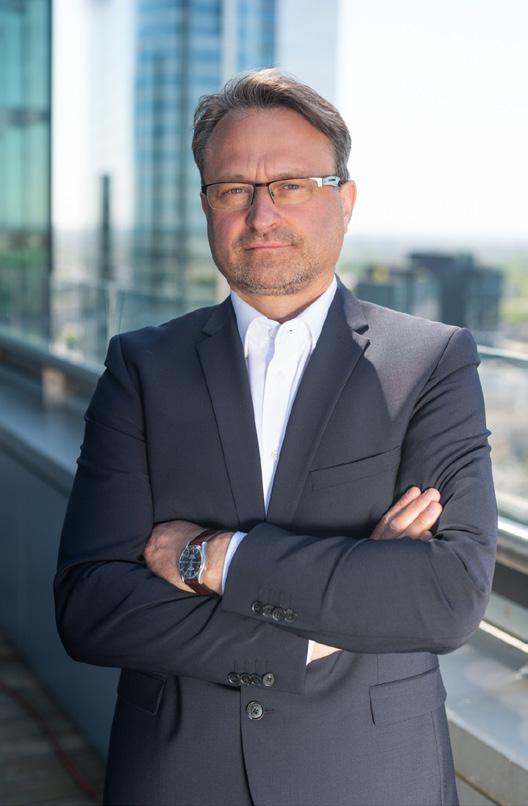
es in supply chains and the relocation of companies from war-stricken Ukraine. Rental rates have been upward for at least the past two quarters, especially for new projects, which must consider higher construction costs. Financing costs are also rising, and as a result, yields have stopped falling. Capitalization rates for the best warehouse prod ucts ranged between 4.7% and 5%.
The rise in mortgage interest rates and the massive in flux of refugees from Ukraine have generated solid rental demand, resulting in a sharp increase in rental rates in Po land’s major cities. In addition, the decline in individual apartment sales has prompted many developers to partner with funds investing in the PRS. For the time being, there are not many deals on the market due to rather long deci sion-making processes and investors’ problems related to increased financing costs. However, the sector’s potential seems relatively high, and we can expect a rebound and a lot of investor activity already in the year’s second half.
“Currently, it is worth noting that the attention and the objectives of foreign funds are focused on the search for al ternative real estate classes outside the logistics and ware house sectors. This is a good forecast for the rest of the market segments, especially office, as it means renewed movement and interesting acquisitions in the coming months of the year,” summarizes Chmielak.
The high performance of the retail sector was main ly due to two transactions finalized by EPP worth EUR 653 million, which involved approximately 50% stakes in two retail property portfolios: PIMCO and I Group – as a consequence of EPP’s delisting from the Johannesburg and Luxembourg stock exchanges. The remaining sales were primarily from retail parks and free-standing gro cery stores. It’s the favorite product category of choice for funds, which have invested heavily in smaller formats in Poland for several years. This product category has not lost its popularity even during the COVID-19 pandemic.
The industrial sector with lower performance, but still on the upswing
The warehouse sector performed 25% lower than last year. Transaction volume closed at EUR 0.7 billion, which is a temporary effect. Logistics and industrial assets continue to attract investors. Demand in the rental market remains high, driven by e-commerce. In the coming quarters, there will be an increasing share of production related to chang
THE RISE IN MORTGAGE INTEREST RATES AND THE MASSIVE INFLUX OF REFUGEES FROM UKRAINE HAVE GENERATED SOLID RENTAL DEMAND, RESULTING IN A SHARP INCREASE IN RENTAL RATES IN POLAND’S MAJOR CITIES. IN ADDITION, THE DECLINE IN INDIVIDUAL APARTMENT SALES HAS PROMPTED MANY DEVELOPERS TO PARTNER WITH FUNDS INVESTING IN THE PRSGrzegorz Chmielak, Head of Valuation and Capital Markets, AXI IMMO
1/ Ultimately Smoky Olfactory Pleasure
Amouage has added a brand-new member to its Library Collection - Opus XIV - Roy al Tobacco. This daring and modern spicysmoky creation is a fragrant travel along the Tropic of Cancer from Oman to Cuba, connecting their two iconic treasuresRoyal Frankincense to Regal Tobacco. Their vertical signature imprints the entire evolution of the perfume, each enriched with supporting notes that reveal and sub lime their complex personality. Aromatic flashes of cardamom and elemi light up a voluptuous heart shining with many facets of flowers and balsams casting their reflec tions upon the evocative accord of frankin cense and tobacco duo. Opus XIV - Royal Tobacco is a daring, lavish, deep and mod ern creation fit for men and women alike.

True to the Omani heritage of Amouage, Opus XIV – Royal Tobacco is housed in an iconic “Khanjar”-inspired bottle with an organic ceramic finish in earthy truffle and cashmere colors.
2/ Five Dimensions of Skin Rejuvenation
The next generation of Natura Bisse’s emblematic Diamond Extreme, takes
it even further in recharging the skin’s energy with a more advanced global anti-aging solution. A new cutting-edge formula of this luxurious cream is en hanced with Smart Energy Complex, a blend of Artemia salina, extract of peony root and ChronoSkin that com plements the skin’s circadian rhythms of daytime protection and nighttime reparation, boosting skin energy and delivering impressive age-defying bene fits. Other precious ingredients include mastic crystal tear oil, pea extracts and Ceratonia siliqua which reduce the ap pearance of sagginess while perfecting facial contours. Peptixyl ProYouth helps lessen the look of wrinkles and expres sion lines. Niacinamide, phytosphin gosine and a blend of plumping effect lipids intensely hydrate to reveal supple and soft skin. A blend of prebiotics and antioxidants helps minimize the effects of external stressors to provide a visible lifting effect.
The renewed Diamond Extreme is available in two textures. The light texture is ideal for those who look for fast-absorbing creams and a matt finish

and the rich texture will please those who prefer an emollient cream.
3/ Urban Scent with NYC Spirit
Maison Francis Kurkdjian 724 Eau de Par fum is a luminous and vibrant fragrance that reinterprets the electrifying and inciting en ergy of New York City. It invites you to live scented living in harmony with the city and keep with its beat for 24 hours of seven days a week. 724 offers an abstract olfactory com position of shades of white with overlapping textures to bring about the protective com fort of being in a big buzzing city.
An urban accord in the top notes can be felt thanks to clean, energizing fresh ness like the one that emanates from New York laundries at the break of day, formed of bergamot from Italy and aldehydes with sophisticated, slightly metallic, efferves cent facets. At the heart of the fragrance lies an airy aura conveyed by a bouquet of flowers structured by jasmine absolute from Egypt, sweet pea and mock orange. In the base notes, it surrenders to an en veloping, comforting sensation thanks to a sandalwood-white musk accord. All available now on www.missala.pl

THE BUZZ
Nordic Painting on Show

he art of the North is still unknown in Poland but Warsaw’s National Museum in cooperation with the Göte borgs Konstmuseum is preparing an ambitious project enti tled “Solstice. Nordic Painting (1880-1910).” An exhibition of works by some of the greatest artists from Sweden, Norway, Iceland, Denmark, and Finland from the turn of the 19th and 20th centuries will be the first cross-sectional show of Nordic art in this part of Europe.
T
The exhibition’s title references the Summer Solstice (Midsommar), a time of year of particular importance in Scandinavian culture, rich in traditions connected with natural phenomena and light. The word “solstice” also alludes to the changes that took place in Nordic painting in the late 19th and the early 20th centuries. This was the period of the greatest flourishing of Scandinavian art, a time when new subjects and means of representation developed - from a realistic reflection of the
world to symbolism to very individual expressions of form and color.
The Warsaw exhibition aims to show a balanced selection of represen tative works by the major artists from the region and to display them in the context of the historical, social, and cultural changes occurring in this part of Europe in the years 1880 to 1910.
More than one hundred works of art from leading museums and collections of Nordic art in North ern European countries will be dis played. The exhibition’s narrative will concentrate around several issues typical of northern art, such as: nature and its impact on human life, work, home and family, nation al myths and legends, metaphysical landscapes and people’s “inner” being. Also presented will be two phenomena representing the overlap of artistic culture and social life: the work of female artists and the artist colony in Skagen, Denmark.
Exhibitions of paintings from Nor dic countries held in Europe and the USA in recent years have enjoyed tre mendous popularity. Works of north ern artists appear in the permanent collections of many major museums. On view from November 18, 2022 to March 5, 2023.
Fascinating glimpses of Warsaw in the 1990s
can also watch documentary films about Warsaw in the 1990s, made by eminent filmmakers: Krzysztof Kieślowski, Mar cel Łoziński and Barbara Sass.
Exhibition can be seen from Oct.20, 2022 to Jan. 1., 2023
The 1990s which was a time of transformation, contrasts and breakthroughs for the whole of Po land. The exhibition “Flash, mat, color” to open at the Museum of Warsaw from October 20 will show how the Polish capital was captured in photographs in those days.
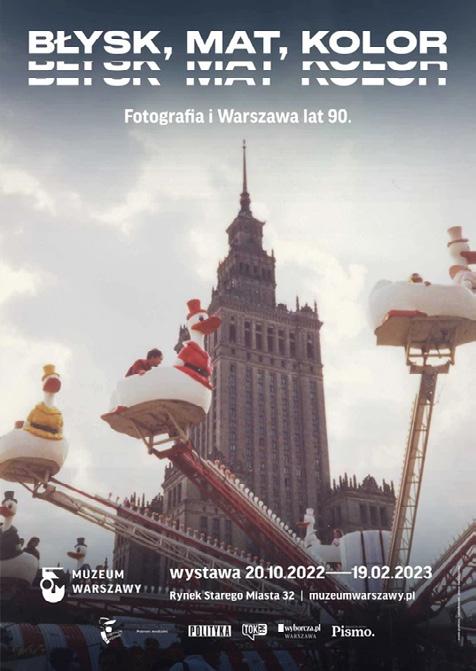
Back then, analogue photography was a common way of recording reality and Warsaw, like a lens, brought into focus the political, social, and economic changes that took place in Poland as a result of the collapse of the communist system. The city space suddenly filled with ubiquitous, colorful advertising, glass skyscrapers started springing up and free trade was taken to the streets.
The exhibition brings together over a thousand exhibits including and photographs by such Polish artists as Edward Hartwig, Chris Niedenthal and Tadeusz Rolke. But it also draws on the archives of photojournalists and private family albums. Whenever possible, original materials are presented like small prints, contact sheets and slide projections. Visitors
Five Flavors of Asian Film The best of Ukrainian cinema brought to Polish audience
Five Flavours Asian Film Festival, a unique review of East and South-East Asian cinema, will be held for the 16th time in Warsaw, this year in hybrid form between November 16 and December 4, 2022.
Five Flavours Asian Film Festival, a unique review of East and South-East Asian cinema, will be held for the 16th time in Warsaw, this year in hybrid form between November 16 and December 4, 2022.
The wide selection comprised mostly of titles unknown in Poland, unavailable in regular distribution. The festival selec tors take care of thematic and genre diversity - the program in cludes popular cinema, daring works of independent filmmak ers, avant-garde and original projects, socially engaged films and commercial blockbusters.
This year’s festival audience have a choice of five sections: a retrospective of films directed by Edward Yang, a pioneer of Taiwan’s New Wave movement, Hong Kong cinema from the last 25 years, Japanese feel-good films, New Asian Cinema and Asian Cinerama, a selection of the award-winning Asian films from the last year.
The festival is also an opportunity to discover Asian pop culture, discuss art, politics, and the challenges of the modern world. The screenings are accompanied by meetings with au thors, in-depth discussions on topics related to the program, lectures and other events aimed at presenting the contemporary face of Asian cultures and their diversity.
Stationary films will be shown in the Muranów and Kinoteka cinemas in Warsaw from November 16 to 23, while the online edition at piecsmakow.pl will last until December 4.
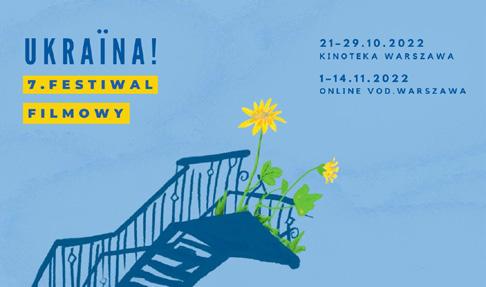

Ukraine!, the only Ukrainian film festival in Poland, will be held for the seventh time. Over 50 films will be shown on October 21-29, including new features, documentaries, and short films at the Kinoteka in Warsaw. Ukraine! will also visit several Polish cities and from No vember 1 to 14 it will be available online on the VOD Warszawa platform.
This year’s festival will feature four sections: Faces of Ukraine, Women’s stories, Art of freedom and Mariupol. Viewers will have the opportunity to watch the best and award-winning films that have been made in Ukraine in recent years.
The festival program includes films about the women’s hard ships: those stuck in the penitentiary system - “107 Mothers” by Péter Kerekes (presented at the Venice Festival) and those look ing for missing relatives (“Mother of Apostles”, directed by Zaza Buadze and awarded with over 50 film prizes). Other films tell about the Russian invasion of Ukraine, like the Ukrainian-Turkish production “Klondike” by Maryna Er Gorbach which was award ed at the Festival in Berlin and “Pamphir” by Dmytro Sukholyt kyy-Sobchuk, which was a harbinger of the upcoming drama.
The festival will be accompanied by meetings with filmmakers and debates with film experts, concerts, and an exhibition of draw ings by Anatoly Ljutjuka.
“We want the festival to speak with the voice of a real Ukraine, so we invited Ukrainians who have been living in Poland for several years to join the program team,” said Beata Bierońska-Lach, direc tor of the festival.
“We want the festival to build a symbolic bridge between Poles and Ukrainians, to be an opportunity to talk and have fun togeth er,” she added.
Olympus, a new diploma play by students of the National Academy of Dramatic Art in Warsaw is staged at Col legium Nobilium Theater.
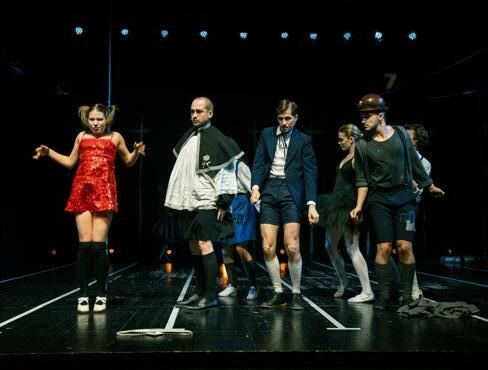
Directed by one of Poland’s most recognized musical directors Wojciech Kościelniak, Olympus (Olimp in Polish), is based on the ancient text of Odyssey, however, not in a literal, sense. Individ ual plots, places of action and relations between the characters have been mod ified in an attempt to look at Homer’s epic from today’s perspective.
Kościelniak’s adaptation is looking at the real fear which, despite the taming of pop culture monsters, has remained, and perhaps even grown in human be ings and holds people back from discov ering themselves. “New lands turn out to be imaginary places, powerful and
Olympus at Collegium Nobilium Theater
vengeful gods inhabit religion and politics, and heavenly beauti ful goddesses tempt from advertising and social networks,” says Kościelniak.
Olympus at Collegium Nobilium looks at Homer’s Odyssey through the eyes of children as they seem to experience such feelings most strongly, especially when they begin their tran sition to adolescence and then to adulthood gaining a wider awareness of existence and transience. “This is the time when conflicts, rejections, failures, fascinations and fears seem to be the most important and final,” according to Kościelniak.
The original Odyssey is a fairy tale, full of fantastic lands, creatures, adventures and phenomena. With computer tech niques, all these supernatural wonders are brought to life on the theater screen.
The play was choreographed by Zofia Grażyńska, music was written by Piotr Dziubek and stage and costumes were designed by Anna Chadaj.
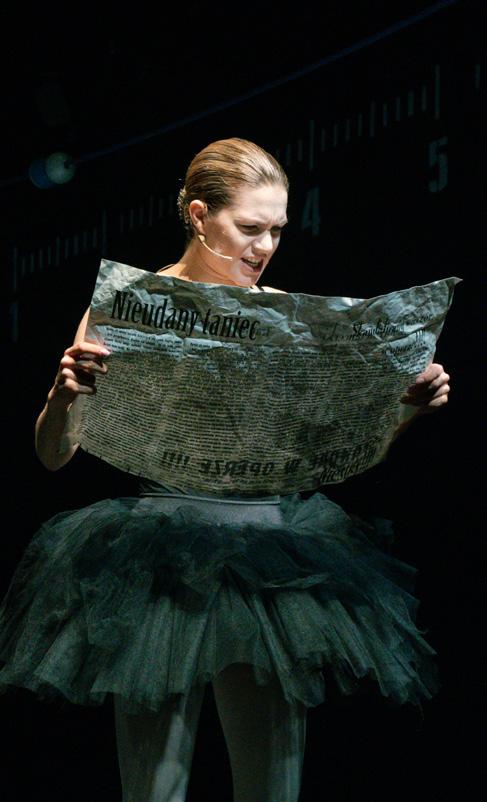
Artistic commentary on Polish post-transformation landscape
Zachęta National Gallery of Art is staging the first comprehensive presentation of Mariola Przy jemska’s works, bringing together oeuvre from all periods of her career. By critics and art histori ans, the artist is considered one of the figures who most accu rately conveyed the post-transformation chaos in Poland after 1989. The free market, the influx of goods from the West and the consumption frenzy have taken over not only society itself, but also visual culture. Przyjemska aptly captured the quivering spirit of consumer capitalism, using in her works large-format advertising banners, clothing labels and packag ing of luxurious-looking products.
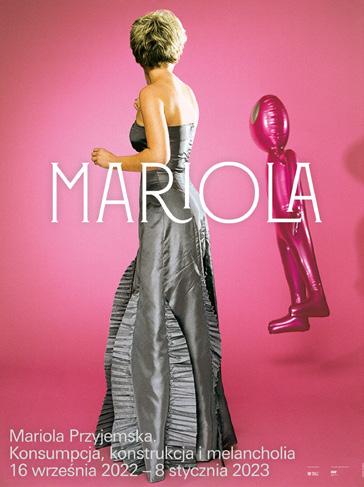
In the 1980s she managed to develop an autonomous vision of “mystical painting” with transgressive elements sometimes referring to religious iconography. However, her style un derwent many changes later. In the 21st centu ry, she started painting more abstract, geomet ric patterns, sometimes with flowers or symbolic ornaments. in which she sought the fullest possi ble experience of seeing.
Przyjemska also cre ated installations, sculp tures, interventions in urban space and took photographs. Her wellknown photographic se ries, Sector 9, was dedi cated to one of the Warsaw necropolises. She was interested not so much in impressive tombstones and monuments, but in the trash ornaments and kitschy candles available at the stalls by the cemeteries.
The monographic exhibition Consumption, Construction and Melancholia at Zacheta presents more than 100 works created over the last four decades in which Przyjemska draws on both cutting-edge and traditional media, from painting and drawing to photography and video, in an innovative way.
Until January 8, 2023
Exhibition Pays Tribute to 1944 Wola Massacre Victims
An exhibition entitled “Wola 1944” commemorates thousands of civilians mass-executed by the Nazi Germans in Warsaw’s western Wola district in the first days of the 1944 Warsaw Uprising, in retalia tion for the city’s revolt against its occupants.
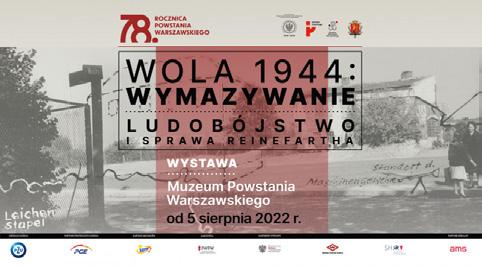
From August 5 to 7, 1944, German SS troops under Grup penfuehrer Heinz Reinefahrth and collaborating forces killed an estimated 15,000 to 60,000 people in Wola and the adjacent Ochota, both districts considered by the Germans to be most in need of “cleansing” from insurgents and civilians. The killings followed an express order by Adolf Hitler to annihilate all civil ians in the area.
The exhibition staged at the Warsaw Uprising Museum pres ents the course of events in Wola in early August 1944 from the perspective of the district’s inhabitants. The exhibits include victims’ personal belongings and survivors’ testimonies. Show casing a collection of over 100 photographs from the 1961-1967 files of the prosecutor’s office in Flensburg the exhibition tells the story of the criminal proceedings against Reinefarth, which ultimately ended in discontinuation. It also features an interview given by Reinefarth to West German television in 1964 in which he denied the crimes, saying that even if any crimes took place, he did not have any knowledge of them or they were committed by other units.
After the war, Reinefarth worked in West Germany as a law yer, became mayor of the town of Westerland on the island of Sylt and a member of the Schleswig-Holstein Landtag regional parliament in Germany. Despite many efforts, he was never held accountable and died in 1979.
The Wola 1944: Erasing Memories, Genocide and Reinefarth’s Case exhibition is on view till July 4, 2023
Matilda the Musical hits Warsaw Rodin - Father of Modern Sculpture at Łazienki
An exhibition “The Essence of Impressionism. Ro din’s sculptures” in the Palace on the Island at the Royal Łazienki Museum sheds light on the philoso phy behind the works of the French artist and his attitude towards art.
Matilda, the musical hit from West End and Broad way has been brought to the Polish stage by the ar tistic director of the Syrena Theater, Jacek Mikoła jczyk. He translated the libretto and directed the premiere performance, first at the Kameralny Theater in Bydgoszcz, and at the Syrena, on September 10.
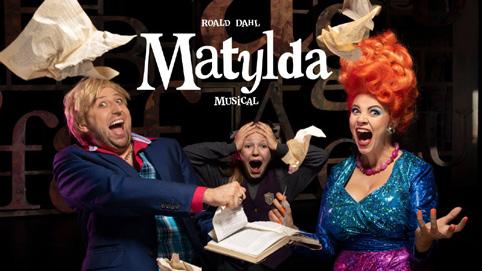
Matilda’s libretto was written by Dennis Kelly, with music and lyrics by a famous Australian comedian and musician Tim Minchin. The musical is an adaptation of Roald Dahl’s novel of the same title, a literary classic for children and teenagers. The protagonist is a resolute girl with extraordinary abilities, im mersed in books, brought up in a family mindlessly staring at the TV screen. She goes to a school ruled by the despotic headmis tress Agata Łomot, who hates children and punishes them for the slightest offenses. Fortunately, Matilda meets friendly people who try to help her at all costs. Thanks to the solidarity of her school friends, a children’s revolution breaks out.
“This is a show with children heroes, but not only for children, it also has an important message directed at adult viewers,” says Mikołajczyk, who has created a spectacle that is both amusing and moving. “It talks about important issues in an emotional, contemporary way, he adds. “In Matilda, kids stick together to defend themselves against the tyranny of adults. The show also exposes the meaning of “girl power”, when a wise and brave girl starts repairing the world.”
The cast of the Warsaw production of the musical was se lected in auditions for professional and child actors. Matilda is played by Łucja Dobrogowska, Julia Kołodziejak and Emilia La sak. The performers also include the leading artists of the Polish musical stage Damian Aleksander, Przemysław Glapiński (as Agata Lomot) Edyta Krzemień and Magdalena Placek-Boryń (as Panna Miodek, Matilda’s teacher).
Thanks to the fantastic choreography by Jarosław Staniek and Katarzyna Zielonka, great costumes by Tomasz Jacyków, the wonderful stage design and multimedia projections by Mariusz Napierała and the music brilliantly performed live by the band led by Tomasz Filipczak, Matilda is a true feast for the eyes and ears. Upcoming performances at the Syrena Theater - December 15-18
Auguste Rodin (18401917) was an eminent French artist and fore runner of modern sculp ture. A sculptor of sump tuous bronze and marble figures, he also produced numerous book illustra tions, dry-point etchings and life drawings.
While academic sculp tors valued the idealiza tion of the figures they depicted, Rodin believed that art had strayed too far from real life and the challenges of the new era. For the needs of sculpture, he adopted the formal and stylistic prin ciples of impressionism, and his works heralded modernism.
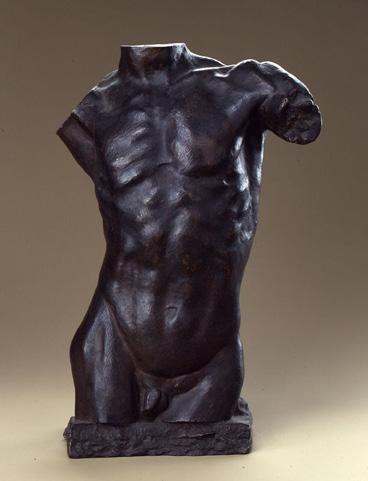
The impressionism, as we know it, is most often discussed around painting. Rodin’s relationship with this trend in art is therefore not straightforward and obvious from a historical point of view, but his works in their own way embody the essence of impressionism in its basic principles: movement, spontaneity and light.
On show at Łazienki are three works by Rodin from the collection of the Dresden State Art Collections: “Jean d’Aire”, “Eva” and the small “Male Torso”. These sculptures provide insight into aspects of his work, such as material, movement, and emotional states of man, which were of great importance to the artist. He reduced the elements of his work to those which form the essence of things. He deliberately left parts of a block of stone unfinished to lend suspense to his sculptures and give the audience room for imagination. Rodin shared his passion for the non-finito technique with Michelangelo, who had created his works more than three centuries earlier. Complex experiments and a combination of tradition and innovation made the French sculptor one of the most technologically advanced artists. On view through Nov. 15.
4/ Bring the Bounce Back Swiss spa and beauty brand Valmont has launched the V-Firm skincare collection and an all-new spa treatment. The new range is dedicated to restoring skin’s firmness, whether that stems from the loss of tone or depletion in the skin’s elasticity.

American dermatologists distinguish three major facial aging categories: “Wrinklers” are faces with a tendency to develop deep and profuse wrinkles. “Sinkers”describes faces that tend to de flate, leaving the underlying bone struc ture highly visible.“Saggers”applies to faces that grow heavy, flaccid and lacking of tone. Valmont’s three V-Firm formulas offer an effective response for “Sinkers” and “Saggers”, revivifying skin drained of substance and support. According to Sophie Vann Guillon, CEO of Valmont, “V-Firm achieves the challenge of techni cality in voluptuousness, combining visi ble efficiency and prolonged pleasure”.
The anti-aging beauty line includes three high-performance products - a se rum, eye gel and cream -combined to optimize bounce, density, and firmness. The secret behind the success is a blend of tried and tested and state-of-the-art com ponents - a peptide cocktail, a density com plex, Triple DNA, a Valmont signature ingredient, and the RNA liposome. These precious ingredients work together to pro duce and synthetize collagen and restore density and thickness in the dermis.
The V-Firm Serum is an ultra-concen trated treatment which targets sagging skin. By strengthening the structure of the dermis, it restores the skin’s firmness and tones the face.
The V-Firm Cream contains re-den sifying active ingredients which work in synergy with plant-based squalene to strengthen the skin’s natural barrier fos tering dermal density. From 28 days, the face reveals a younger appearance with sharper contours, thanks to regained elasticity.
The V-Firm Eye is an amber-hued balm with a “honey gel” texture. It is said to actively combat sagging eyelids and under-eye creases. Hyaluronic acid coats the skin like a hydrating, tensing film, complementing the in-depth action of V-Firm’s core formula (Peptide Cocktail, Density Complex and DNA/RNA duo).
In conjunction with the new launch, Valmont has devised a 60-minute
spa treatment designed to heighten the skin’s firmness to reveal a visibly younger face with enhanced volume definition. The facial begins with a lux urious warm-up based on Valmont’s unique method. This step cleanses the face to make it ready to soak up the benefits of the treatment. This is fol lowed by a sculpting and re-modelling massage, incorporating deep tissue massage techniques. Main gestures include deep kneading, palpating and rolling, as well as powerful smoothing motions. The ritual is carried out with the utmost precision thanks to Firm-C Boost, a concentrated massage serum which delivers triple DNA, vitamin c
and collagen fragments deep into the skin for heightened elasticity. This is followed by Valmont’s Regenerating Mask Treatment collagen veil, while the beautician massages the shoul ders.
A succession of products - including hydrating primer, serum, cream, and therapeutic cream for the neck and un der-eye area - are then applied to steep the skin in anti-ageing and firming ingre dients. Finally, the treatment is concluded with a soothing hand massage. Valmont complements the experience with thera peutic sound frequencies composed as part of a partnership with Swiss musician Ripperton.
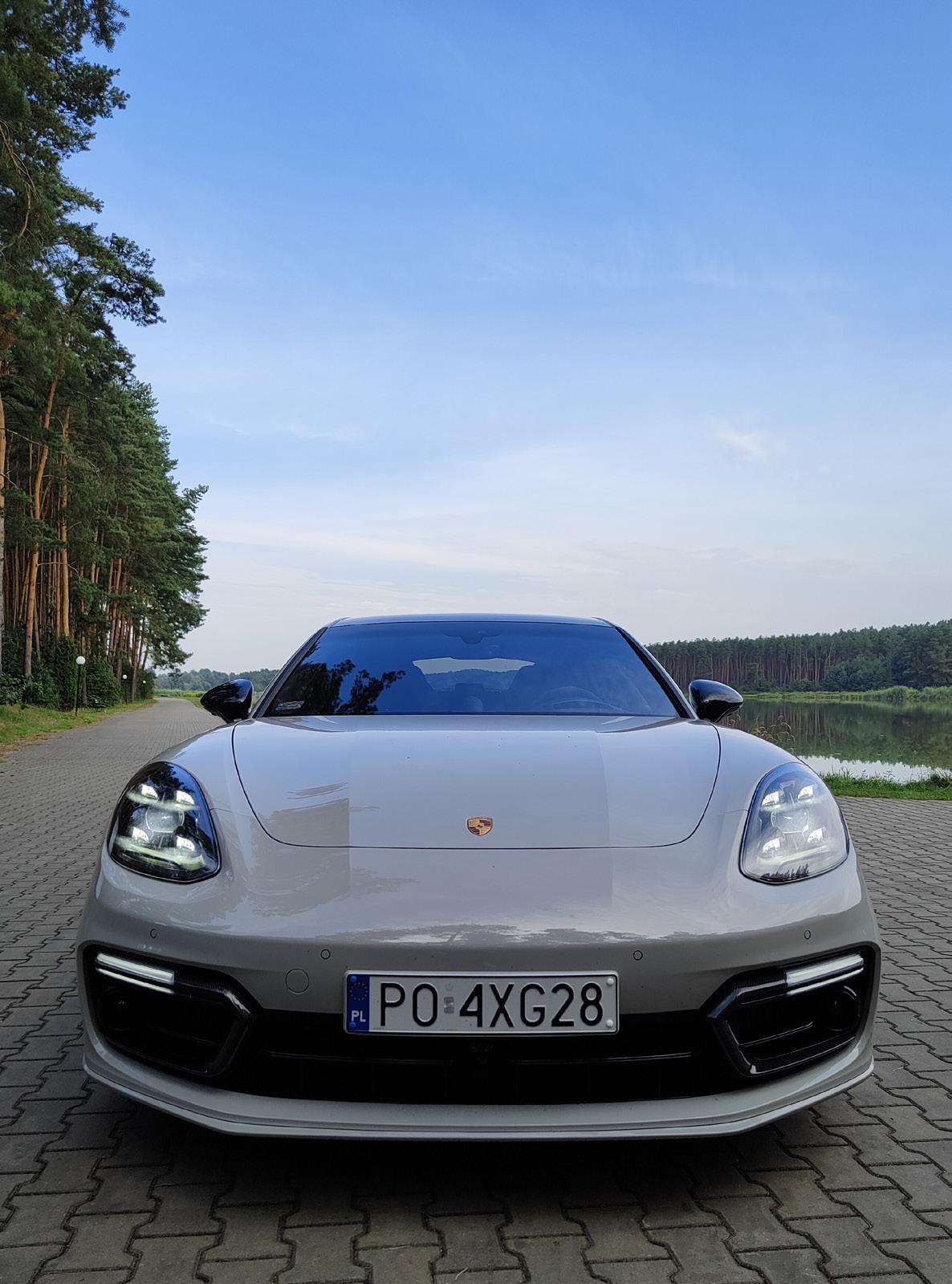
he Porsche Panamera is a unique car that offers the sporty driving experience of a Porsche 911 with the comfort and function ality of a spacious limousine. Could it be the perfect combination?

To be honest, I was once not an admirer of the Porsche brand. Maybe someone will say that this is sacrilege, but I remember that the Porsche 911 model didn’t make some kind of electrifying impression on me. When, over the years, I traveled to Italy, Germany, or Austria for presen tations of its successive model or facelifted versions, I was one of the few journalists who did not marvel at them. It wasn’t about engines or traction qualities because these were always unquestionably sensational. The problem was with the appearance of the car. What I didn’t like was not so much the exterior design, but a certain imbalance of proportions in the silhouette of the car. Looking at the sideline - a short wheelbase and large body overhangs at the front and rear - I felt aesthetically disappointed every time. Not to mention that I could never get comfortable in the cramped interior, and the vertically positioned steering column was more annoying than a pleasure to drive. In short - what for others was indescribable hap piness and joy, for me was an ordinary ride, the fact that an extraordinary car. Until came 2011 and the presenta tion of the seventh generation of the model with the fac tory code 991, after which my aesthetic perception of the model changed completely, to turn me from a skeptic into a die-hard fan of the brand and the model with the eighth generation (992) - on the market since 2018. Beauty and power finally go hand in hand and enlarging the body dimensions and balancing its proportions have done won ders. And how not to believe the statement that size does matter after all.
Not everyone knows that back in the late 1980s Porsche prepared a prototype of a four-door version of the 911 model, designated 989. The idea of a four-door limousine was finally realized, only two decades later. In 2009, the first generation of the Panamera model was un veiled, whose name was borrowed from the legendary La Carrera Panamericana auto race. The nearly five-meterlong limousine, with the factory code 970, fastback body (the rear tailgate lifts together with the windshield) and a gently sloping roof like that of a coupe car, referred di rectly to the brand’s sporting genes with its styling and caused quite a sensation in the car market. Equipped with powerful turbocharged diesel, gasoline and hybrid engines, two-wheel drive or fast PDK dual-clutch auto matic transmissions, the model successfully competed with such rivals on the market as the Audi A7, BMW 6 Series Gran Coupe and Mercedes CLS.
THE NEW PANAMERA WAS CREATED COMPLETELY FROM SCRATCH
The second generation Panamera, designated 971, was unveiled in 2016, and the new Panamera was created completely from scratch. One would like to say - fortu nately, because, as in the case of the Porsche 911, the car not only grew compared to its predecessor - it is longer, wider, and taller, (even the wheelbase increased by 30 mm) but also gained its own and unique styling. While
the previous version of the Panamera was criticize d for its “squat and sluggish” silhouette, especially the rear part of the body, the second generation, despite its larger dimensions (5.05 m. long) and despite its muscularity, seems to be slenderer and more lightweight. The body, set on 21-inch rims, is dynamic, with pronounced body ribbing and, finally, a sleek, though still wide, and solid rear end, which, thanks to the exterior mirrors, can, as in the 911, also be seen from the driver’s seat. As can the rear spoiler, which slides out from the tailgate and un folds automatically at speeds above 95 km/h. Yes, this is definitely a sporty model. The dynamic body is superbly complemented by the stylistic front headlights and nar row rear lamps, connected by a light bar with LED tech nology. Particularly in the evening or at night, the sight of the Panamera riding on the lights is intriguing and delightful. The rear lights have already become a recog nizable design element of all new models of the brand.
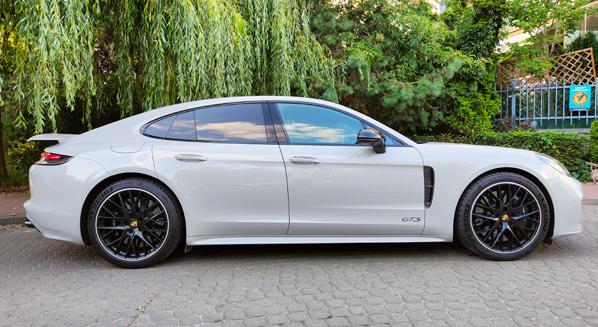
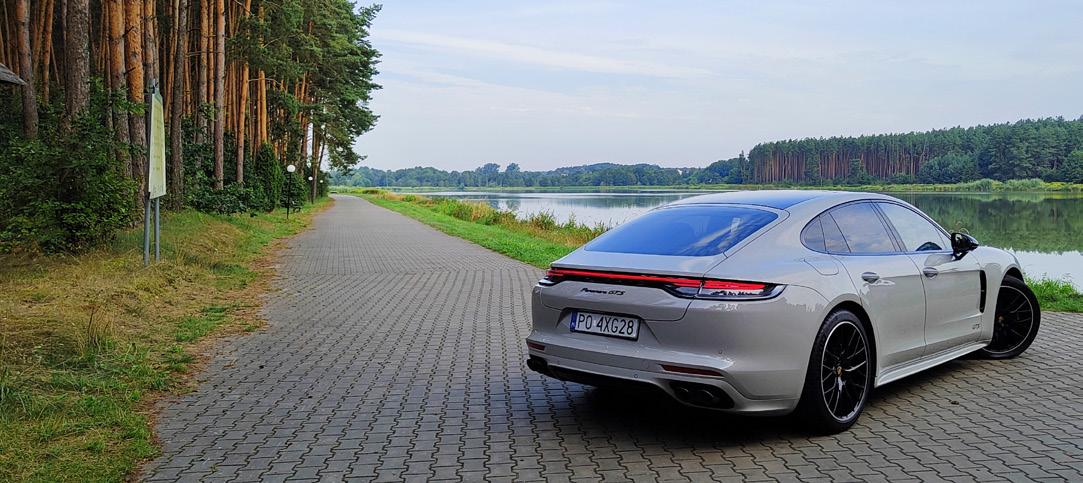
The interior is spacious. It accommodates four buck et seats, for four passengers. In the passenger cabin, one feels with all the senses - by sight, touch and even smell the luxury surrounding from everywhere. The nat ural finishing materials are of the highest quality, and
the attention to detail or the fit of the various interior components is not the least bit objectionable. The threespoke, multifunctional - sports steering wheel, trimmed with alcantara, lies perfectly in the hands. In front of the driver are the traditional round Porsche clocks, with the tachometer clock in the central position. As in all cars of the brand, the ignition is also on the left side of the steering column. The beautiful clock in the center of the dashboard, the wide touchscreen with automatic closing and opening air conditioning vents underneath it, and the touchscreen panel in the center tunnel with the gear

shift lever centrally located on it and control buttons for air conditioning, system menus, suspension and traction control are all impressive. It looks modern and impressive, although, in my opinion, just in this regard, the first gen eration Panamera-in which the so-called center tunnel was not touch-sensitive and had the usual aluminum manual control buttons-was more elegant and ergonomic. Times change, however, and so the ubiquitous touch panels have become an indispensable part of the de sign of modern cars. It’s a bit of a shame. Instead, there is a 495-liter trunk at the passengers’ disposal. After folding the rear backrests, its capacity can in crease to 1,334 liters. Admittedly, the trunk is narrow and has a high loading threshold, but if necessary, the Panamera can successfully serve as a luxurious and functional family car.
Under the hood of the Panamera GTS is a 4-liter V8 engine with two turbochargers, with 480 horsepower and 620 Nm of torque. These parame ters allow acceleration to the first hundred in just 3.9 seconds and a top speed of 300 km/h. Drive is transmitted to all wheels, with the rear axle strongly favored, via an 8-speed sequential (with pad dle shifters under the steering wheel rim) PDK automatic transmission. The transmission works downright perfect ly, reading almost the driver’s thoughts. Shifting gears is done in a fraction of a second, so that only by the ta chometer pointer or the sound of the engine can we notice when it happens. With a knob on the steering wheel, the driver can select the appropriate driving mode - Normal,
Sport, Sport Plus, Individual - and the electronics do the rest. Not only the operation of the engine, but also other components, such as the suspension, adjusts instantly to the driver’s needs.
In Sport Plus mode, after activating the Sport Response system with a button on the steering wheel (in the center of the knob for changing driving modes), despite four-wheel drive and 315-wide tires at the rear, it only takes a little moisture for the car to lose traction. The torque is so powerful that with Launch Control and even relatively dry pavement, starting off often ends in wheel slippage. The pow er transfer to the wheels is brutal, and acceleration presses you into your seat and resembles a jet plane take off. The sound of an eight-cylinder engine is given gratis. Wanting to safely use the capabilities of the Panamera or any other model of the brand, I would suggest getting help from the professionals working at the Porsche Experience Center Silesia Ring. On a special track in Kamień Śląs ki, under the supervision of instructors, you can learn or improve your driving techniques, which will certainly come in handy when driving a car. I know this from my own experience.

According to technical data, average fuel consumption is 12.1 l./100 km. Fuel consumption, of course, depends on the driving style. Panamera weighs more than two tons, and with a V8/480 hp. engine under the hood and using sport driving modes, it is not difficult to increase consump tion to more than 20 l./100 km. During the test it was also the case that, driving according to the rules on the express
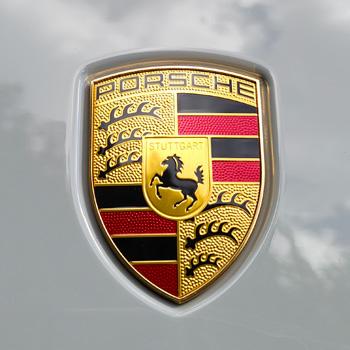
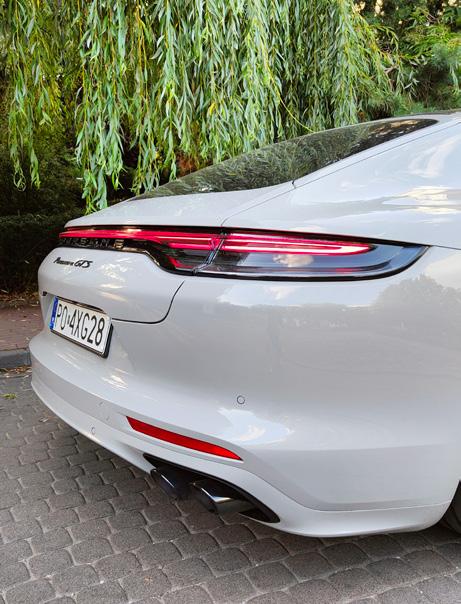
way, the average consumption reported by the computer was 7.6 l./100 km. Unbelievable, but true. I give this value rather as a curiosity, because does anyone who buys a car in the base version for PLN 655,000 pay attention to the combustion? More so to the body color, rims, professional audio system or additional equipment such as rear torsion axle or PDCC (Porsche Dynamic Chassis Control) active
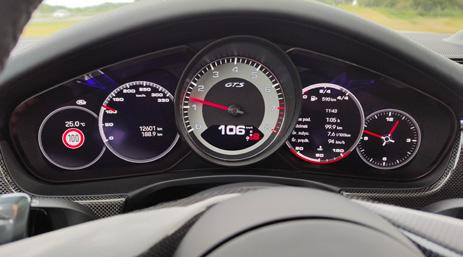
suspension which can increase the price of the car even by several hundred thousand PLN. The Burmester audio system alone in the presented model is an additional cost of about PLN 35,000.

The Porsche Panamera GTS is an exceptional model. Despite its weight and dimensions, it drives like a sporty Porsche 911. It has sensational performance, the transmis sion works perfectly, and you can listen to the sound of the “eight” endlessly. As a free gift, you get a spacious and wellequipped interior, which you can get into comfortably and in which you can enjoy comfort and luxury. It’s an excellent combination, although it’s fair to say for a certain clientele.
Some of the brand’s admirers will still prefer to experience the sporty experience in more spartan driving conditions and will find that the cramped interiors that the iconic 911s offer are worth their sacrifices. And that’s the point. Let ev eryone choose based on their own taste, preferences, and, well, wallet.
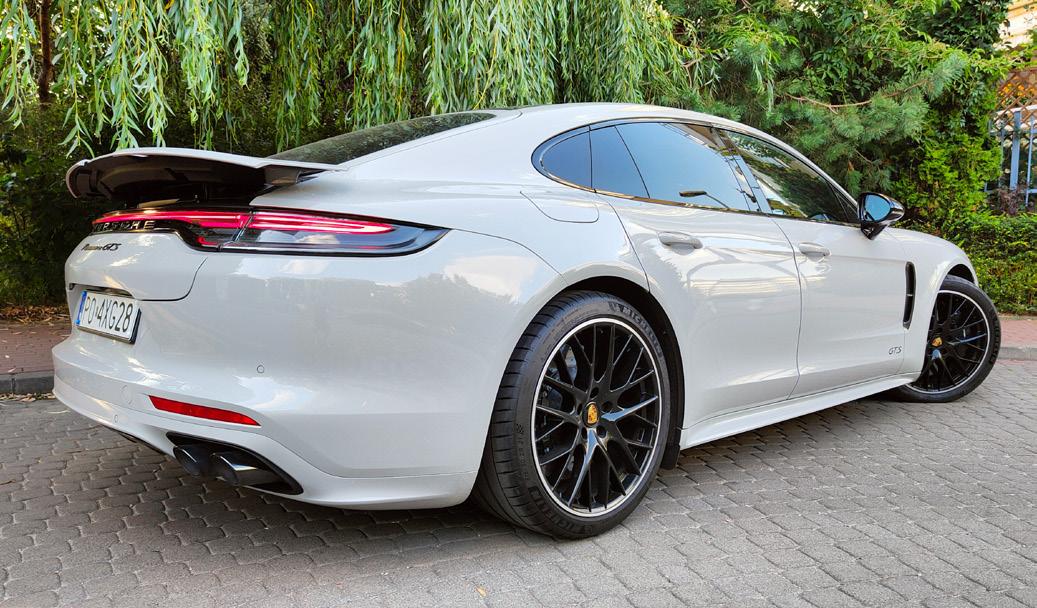
SOME OF THE BRAND’S ADMIRERS WILL STILL PREFER TO EXPERIENCE THE SPORTY EXPERIENCE IN MORE SPARTAN DRIVING CONDITIONS AND WILL FIND THAT THE CRAMPED INTERIORS THAT THE ICONIC 911S OFFER ARE WORTH THEIR SACRIFICES
RENAULT STRENGTHENS ITS POSITION AS THE LEADER IN VAN SALES IN POLAND
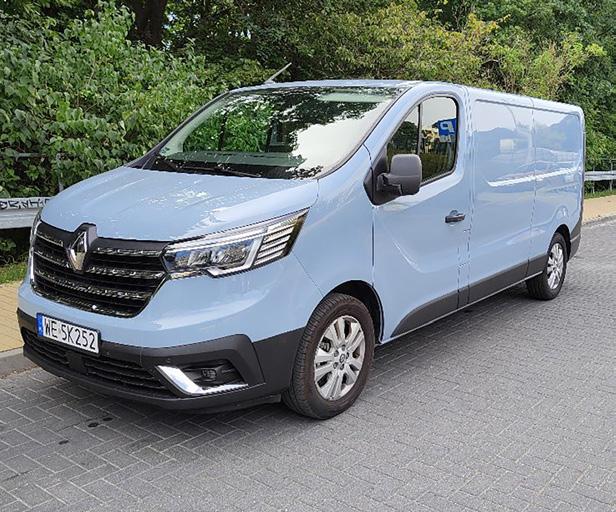
After the first half of the year, Re nault’s sales results for delivery vans in Poland are excellent. In a market down 18%, Renault is up 3.5% and consolidates its leadership position. Renault Master is the Polish market leader and segment leader. The deliv ery Renault Trafic holds TOP3 posi tions, the Express Van TOP 2. The passenger Trafic Combi is the undis puted leader of the minibus segment. Renault in Poland is also the leader in modified vehicles. Specialized bodies have been number 1 on the market for 11 years. From the factory offer, most are sold tippers and open boxes. However, customers most of ten choose locally made bodies, of which by far the most popular is the body for international transport, fol lowed by the shipping container and isotherms.
”It’s worth remembering that we are in the process of refreshing the electric LCV E-Tech range,” says Janusz Chodyła, press attaché for Renault Polska Sp. z o.o. “In June we announced an offer for the New
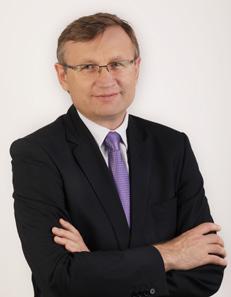
Kangoo Van E-Tech, while in August we announced an offer for the Master E-Tech with an enlarged battery. The range of our electric vans is becoming more and more attractive, especially if we consider that they are to serve in urban spaces,” he adds.
The new Kangoo Van E-Tech can be driven up to 300 km on a single charge (according to the WLTP mea surement cycle), while the traction battery in the Master E-Tech, enlarged to 52 kWh capacity, allows the vehi cle to travel up to 204 km (according to the WLTP measurement cycle). In addition, the charge level of both models can be efficiently replenished if necessary, using DC fast chargers, and the New Kangoo E-Tech boasts an on-board AC charger with a capacity of up to 22kW.
“Currently, most of these types of cars are sold to water and energy com panies. We are seeing an increased number of requests for quotations, which allows us to be optimistic about the development of EV sales in Po land,” Chodyła added.
WHAT’S NEXT FOR INTERNET PRICES?
In recent months, high inflation, and the consequent increase in the prices of products and services, has been af fecting more and more industries. The situation is no different in the telecom munications market, an important part of which are wholesale operators that build fiber-optic infrastructure. In their case, fiber-optic cable prices, after slight declines in recent years, have increased significantly. The projected increase for Q4 over 2020 prices is 45%. Prices for construction and installation works, according to preliminary data from the Central Statistical Office (GUS), rose 13.2% in June compared to the same month last year. In the first quarter of the year, the cost of energy, com pared to 2021, was near ly 70% higher. Accord ing to Prof. Dr. Maciej Rogalski, Rector of War saw Łazarski University and a legal advisor with more than 20 years of experience specializing in telecommunications law, wholesale operators may have to raise rates for access to network infrastructure.
”Inflation is driving up the cost of materials, energy and labor by several tens of percent, which increases the cost of building telecommunications in frastructure,” Rogalski says. “Thus, it seems that for economic reasons it is not possible to maintain the current price level of wholesale services provided to telecommunications entrepreneurs. On the contrary, wholesale operators will not be able to develop a competitive and modern fiber-optic infrastructure, since the telecommunications infrastructure is already built in densely populated, i.e., urban, areas. In contrast, it is not developed in rural, low-density areas, where investment costs are higher. So, in order to fight the digital exclusion of people living there, inflationary increas es may be necessary,” Rogalski adds.
BRIEF Compiled by Bartosz GrzybińskiVOLKSWAGEN’S „WAY TO ZERO”
The Volkswagen Group has become the first automaker to commit to the goals of the Paris Climate Agreement and aims to become a carbon-neutral company by 2050. In line with its “Way to Zero” strategy, the Volkswa gen brand is consistently reducing CO2 emissions, gradually shifting to the use of renewable energy and offsetting unavoidable carbon emis sions. Manifestations of these efforts are the ID.3, ID.4, ID.5, the brand’s first models produced in a CO2-neu tral manner at a factory in Zwickau, Germany, adapted 100% to the pro duction of electric cars. The realiza tion of the brand’s strategy is also easy to see in Volkswagen’s product lineup, with more and more electric or plug-in hybrid cars gradually ap pearing.
”As a brand, we are on the road to carbon neutrality, and we know that this goal will not be achieved over night. We wanted to show that also at the local level, in Poland, we are making efforts to reduce our carbon footprint (not only at the stage of car production or components). In plan
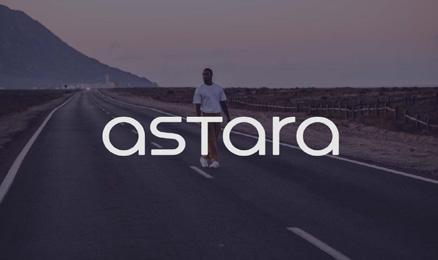
ning this project, we made a simple as sumption: after each test of one of our cars with an internal combustion en gine from the journalistic park, funds will be donated to the Polish Forestry Association to plant 70 trees. This is a standardized value, independent of the car model tested. Importantly, the journalist will be able to choose the area where the planting will be done after the test,” says Hubert Niedziels ki, Volkswagen brand PR manager.
Currently, every second car in Volkswagen’s press fleet has the abil ity to charge from a socket (thanks to an all-electric or plug-in hybrid drive).
The project to offset the carbon footprint of Volkswagen’s press park test cars kicked off with the beginning of 2021. On an annual basis, this initia
tive contributed to the planting of more than 8 hectares of trees (about 50,000 seedlings) in Poland. These were areas affected by natural disasters: a forest in Czarnów, which was completely de stroyed during the 2017 storm; a poststorm area in the village of Ryboły, near the Knyszyńska Forest and Białowieża Forest, resulting from the 2016 hur ricane; and a mountain forest in the Babia Góra region, located in Zawoja in close proximity to the Babia Góra National Park. This year, journalists can choose from three locations - they are Siewierz, Bukowsko and Zubrzyca Dolna. The plan is to plant more than 6 hectares of trees (about 35,000 seed lings) in southern Poland, in locations selected with the support of the Polish Forestry Association.
CHANGE OF COMPANY NAME
MMC Car Poland Sp. z o.o., the general distributor of Mitsubishi Motors cars, spare parts and accessories in Poland, is changing its name to ASTARA Poland Sp. z o.o. In operation since 1979, As tara is one of the world’s largest groups of companies, providing automotive and mobility products and services on three continents, in 19 countries, with more than 230,000 vehicle sales annually. The
new company is planning two launches of new-generation ASX and Colt models which will debut in 2023, as well as dy namic growth in the mobility sector.
”Astara in Poland is a team of au tomotive enthusiasts. A large group of employees has been with the company for 26 years, which is the date the com pany was founded. As an experienced team of automotive experts, we have been responsible for the distribution, sales and service of Mitsubishi cars for more than a quarter of a century,” says Piotr Szewczyk, chief operating officer of Astra Poland. “In 26 years, we have sold more than 100,000 Mitsubishi cars. The network of authorized Mitsubishi Motors dealerships in Poland currently consists of 26 sales points and 40 service stations, which together employ about 1,000 people. Thanks to ASTARA’s innovative solutions, we will be able to respond even better to the growing ex
pectations of customers, offering vari ous forms of vehicle ownership and use - from purchase with multiple forms of financing, to short- and long-term rent al as well as subscription and connec tivity systems. Joining the international and multi-brand ASTARA Group has opened a wide range of opportunities for the company’s development. We are also currently working intensively on plans to cooperate with other brands and imple ment innovative distribution, mobility and connectivity systems. Aiming for the best possible operational efficiency using the group’s expertise and resources, we are also working closely with other coun tries and ASTARA’s regional represen tations. One example is the cooperation with ASTARA Western Europe to inte grate operations for Isuzu Poland, the Polish representative office of the brand, which currently shares office space with us.”, Szewczyk concludes.
NEW PROLOGIS FACILITY
Prologis, a global leader in logistics real estate, is beginning construction of a 50,000 sqm speculative distribu tion facility at Prologis Park Wrocław III. Currently, Park Wrocław III con sists of five buildings with a total area of 137,000 sqm. Customers of this logistics park include companies such as: Acer, Deichmann, DSV, Farutex, Max Fliz, Neuca, Selena and Truvant. Its strategic location in the distribu tion chain is determined by its close proximity to an airport serving direct flights to Warsaw, Frankfurt, Vienna, Copenhagen or Munich. Along the park runs Wrocław’s western inner ring road - that is, the A8 highway.

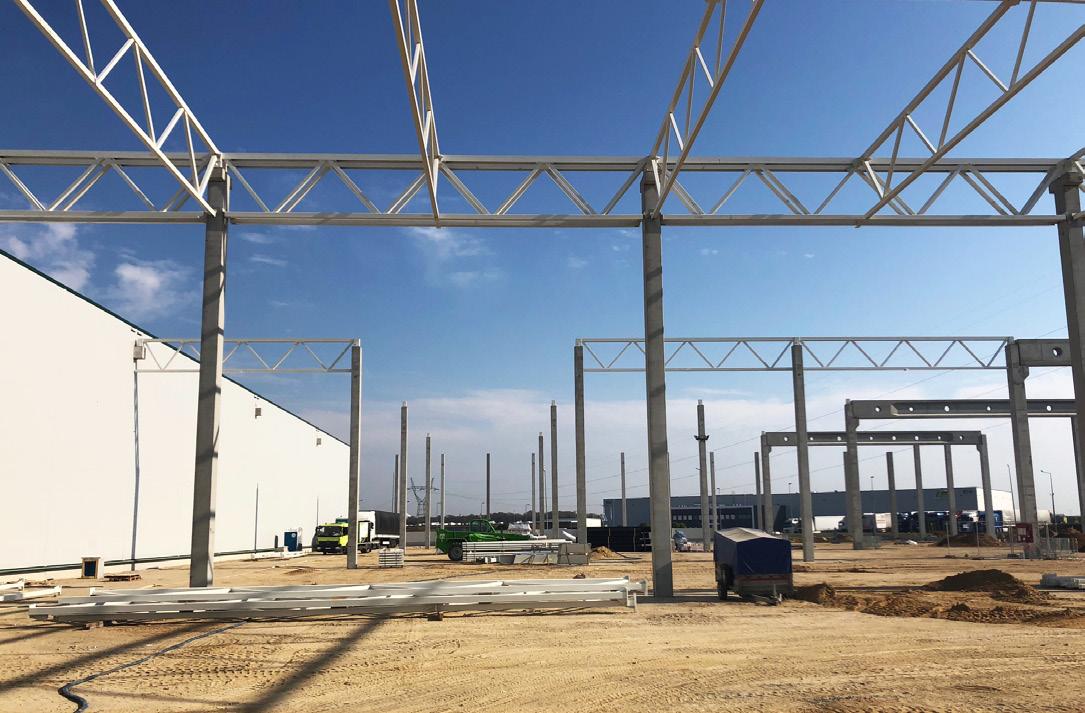
”Our new investment confirms that nothing is impossible for Prologis, and limitations do not exist. Like all indus trial parks, Prologis Park Wrocław III meets the needs of today’s supply chains. In order to meet the needs of customers and their employees, we create our parks to operate as vibrant,
highly functional office and warehouse facilities. When we build our logistics centers, we design them with the entire community in mind, matching them to the area and the local landscape,” says Marcin Czerniewski, Development Manager at Prologis.
The fourth Prologis building, like
the others on the park, will be built to fit the needs of future customers. It will have a clear warehouse height of 12 meters, reinforced floor bearing capacity and increased insulation of the hall’s walls and roof. Construction is scheduled for completion in the sec ond quarter of 2023.
SPACE DECADE FOR POLAND
In November 2012, Poland officially became the 20th member state of the European Space Agency. 10 years ago, the domestic space industry, despite the significant successes of scientists and scientific institutes, practically did not exist.
In 2022, the Polish space sector consists of 330 entities, including more than 150 that participate directly in international projects, about 12,000 employees of companies and R&D centers (in 2020 there were more than 300) and contracts worth more than EUR 140 million. A symbolic summary of the first 10 years of activity in the sector is the debut of the first Polish space company, Creotech Instruments S.A., a leading manufacturer of satellite systems and advanced electronics for quantum tech nologies, on the Main Market of the Warsaw Stock Exchange. The company has been se lected for a project to build the first large-scale quantum computer for the European Union and is also implementing the EagleEye R&D project, based on a proprietary microsatel lite platform, which is developing an Earth observation microsatellite that is expected to ascend to Earth orbit in late 2023/2024.
“In 2012, we decided to take a step that would allow us to establish ourselves in the global space industry. Important points in the development of the space industry in Poland were the establishment of the space agency POLSA in 2014, the development 3 years later of the first Polish Space Strategy and the start of work on the National Space Program. After 10 years, we can already confidently say that not only are we chasing the world’s giants, but we have made our own significant con tribution to the development of the sector, and cooperation with the largest agencies and companies gives us a significant share in global aerospace supply chains and the opportunity to develop technologies, not only in aerospace, but also in
sectors such as IT or telecom,” said Mirosław Hermaszewski, the only Polish astronaut, currently chairman of the Sector Competence Council for the aerospace industry in Poland.
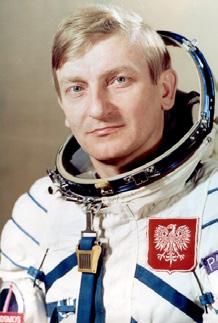
In 2020, the value of the global space economy rose to USD 447 billion, 55% more than 10 years earlier. It is es timated that by 2040 the revenue generated by the space in dustry could grow to more than USD 1 trillion. About onethird of the value of the global space sector is made up of telecommunications services, and it is the area related to the development of satellite systems that has opened the way to space for companies from Poland. Cur rently, the domestic space sector is mainly small and medium-sized enterprises, as well as scientific institutes with extensive expe rience in space exploration and the manu facture of research instruments, which are involved in the exploration of Mars or the Sun, among others. Thanks to participation in and access to ESA infrastructure, Polish entrepreneurs and scientists develop technol ogies, receive financial support, benefit from the experience and knowledge of other coun tries, establish contacts with new partners, participate in groundbreaking projects and become important and recognizable partners in Europe an space programs. At the same time, the value of the do mestic space market is growing and growing dynamically. In 2014, according to various estimates, it was between PLN 7 billion and PLN 12.5 billion, in 2019 the domestic space mar ket was already estimated at PLN 15 billion.
“As part of our contribution to the ESA, we participate in programs of space observation and information, satellite
navigation, telecommunications or construction of scientific instruments. The Polish Industry Incentive Scheme (PLIIS), a program to support Polish entities for 2012-2019, ended in 2019, during which 45% of the Polish contribution to ESA was earmarked for adapting the country’s industry, opera tors and space industry environment to ESA requirements. Almost half a thousand applications were submitted under the project, and more than two hundred of them were com missioned for implementation. This year, the European Space Agency created a brand-new mechanism for Poland, the socalled Industrial Policy Task Force (IPTF), which will allocate EUR 5.6 million exclusively for contracts for Polish entities between 2022 and 2024. These are also funding that Poland pays through a contribution to the ESA, and which will be redirected to specific activities supporting the further devel opment of the Polish space industry,” said Grzegorz Brona, CEO of Creotech and animator of the Sector Competence Council for the aerospace industry.

At the end of October 2012, a month before the ratifica tion of Poland’s accession agreement to the ESA, the Space Sector Employers’ Association started its activities, which ini tially had 19 members. It currently has about 70 members, 70% of whom are micro and small enterprises. Member com panies employ about 5,000 people, generating a total annual revenue of about PLN 1 billion.
“Further development of the space industry requires the development of human resources. Not only engineers, but also specialists in robotics, automation, or mechatronics, but also scientists, designers, or business representatives and an alysts of market and technological trends in various niches of the sector. Training solutions will have to constantly evolve to respond to the current and future needs of the industry,” said Andrzej Banasiak, CEO of Thales Alenia Space in Po land, and member of the Sector Competence Council for the aerospace industry.
The development of the Polish space industry, especially in large ESA projects and scientific missions, will be supported and shaped by entities with foreign capital. To date, the total estimate of the size of projects in which foreign companies have participated as partners from Poland reaches EUR 5 billion.
“Since Poland’s entry into the ESA structures, about 39% of all available funds have been obtained by entities with for
eign capital, which represent about 25% of the Polish space sector entities. About 10% of the most active foreign compa nies in the Polish space sector account for about 85% of the total activity of foreign entities in ESA projects (counting in financial terms, not including expenditures from these com panies for subcontractors),” Banasiak added.
The global space sector in the next decades of the 21st century promises to be extremely active. Later in the 20s of this century, man is likely to return to the Moon, and ESS components and metal structures for the Moon I-Hub transfer station are being built right now in Poland. A mis sion to study the hot intergalactic medium and supermas sive black holes is scheduled to launch in 2028 as part of the Athena project. An advanced telescope for high-energy astrophysics is being built for the mission, which is expect ed to be the largest X-ray telescope ever built - one of the structures is also being built in Poland. Panels for the sat ellite subsystems of the Chime project are also being built in Poland, which, in cooperation with the European Space Agency, will go into orbit and provide unique Earth obser vation data and allow better monitoring of climate change on the planet.
For years, the biggest excitement has been over plans to populate and planetary missions to Mars. The planetary ro bot Curiosity, which has been exploring the surface of Mars since 2012 as part of the Mars Science Laboratory mission, is equipped with a range of scientific instruments, including a tunable laser spectrometer that includes MCT uncooled infrared detectors designed and manufactured in Poland by VIGO System. And if not Mars then perhaps our future will be decided by Earth’s “digital twin,” which, thanks to Cloud Ferro’s innovative cloud technology services, will allow com plex simulations of the functioning of global ecosystems and the development of long-term climate forecasts?
“The Sector Competence Council for the Aerospace In dustry actively promotes the interaction of the entire sector, cooperation with colleges, research centers and universities, as well as education and promotion of the space industry. And the results of this work are already visible in every area of the sector’s operations. Today we are much further ahead than 10 years ago, and I am convinced that space is within our reach,” Hermaszewski concluded.
GREAT GEAR
Compiled by Bartosz Grzybiński1/ Garfish - a dive watch by Polish brand Xicorr
Garfish is a predatory fish that inhabits the rough waters of the Baltic Sea and the Atlantic. The watch with this very name is a novelty in the offer of the Polish watch brand Xicorr. With a professional, diving look, the watch also features the parame ters expected by divers.
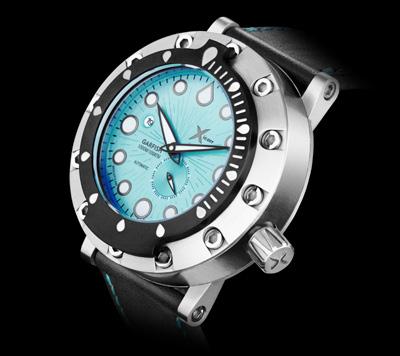
What is certainly surprising is the ex tremely attractive color of the dial of the presented model, which refers to the col or of the bones of this beautiful and slen der fish that is the Garfish. The watch is already offered on the market. www.odczasudoczasu.pl
2/ Mio MiVue C580 - safety in all conditions

The Mio MiVue C580 video recorder is characterized by excellent quality of recorded images even in minimal light. This is possible thanks to the high-quali ty Sony STARVIS CMOS optical sensor, which provides excellent contrast and very bright and rich colors, even in low light. In the case of video recorders, it is the high quality of the recordings that is

C580’s HDR (High Dynamic Range) fea ture, the camera automatically captures multiple frames with different exposure values and then combines these frames to create a single image, which is then optimized to be brighter and clearer with less noise. The Mio MiVue C580, thanks to its built-in GPS, sends warnings about the nearest speed cameras. This is possi ble because this model has the patented Mio Smart Alert feature, which serves as an early alert when a vehicle exceeds the speed limit. It also warns the driver of an approaching speed camera with an alert signal and will tell the driver how fast he or she can drive so that it is the legal speed. With parking mode backed up by an internal battery on standby, the video recorder will automatically start recording as soon as it detects vibrations or movement. Using the Mio SmartBox III’s constant power supply, the device can operate in active parking mode for up to 36 hours.
www.mio.com/pl
Garett Elegance RT
Although smartwatches have a growing number of followers, there are still many people who prefer traditional watches. Some of them do not need technological innova tions. There are also those for whom design is important - the watch should be elegant, classic and complement the image. For such people smartwatches with modern, sporty look are not attractive. To meet the needs of such users, the Garett brand introduced the Garett Elegance RT smartwatch - a smart watch with a classic look, which gives you a choice of bracelet or strap, and thus works well on both female and male hands.
Garett Lady/Men Elegance RT pro vides the wearer with comfort, class and functionality, and the IP67 waterproof rat ing guarantees protection against water, dust and other contaminants. For sports lovers and healthy lifestyle enthusiasts, the smartwatch is equipped with sports modes: running, volleyball, swimming, yoga, basketball, walking or skipping. Health and sports progress can be moni tored thanks to Da Fit application, operat ing on devices with Android and iOS. wwww.garett.com.pl

